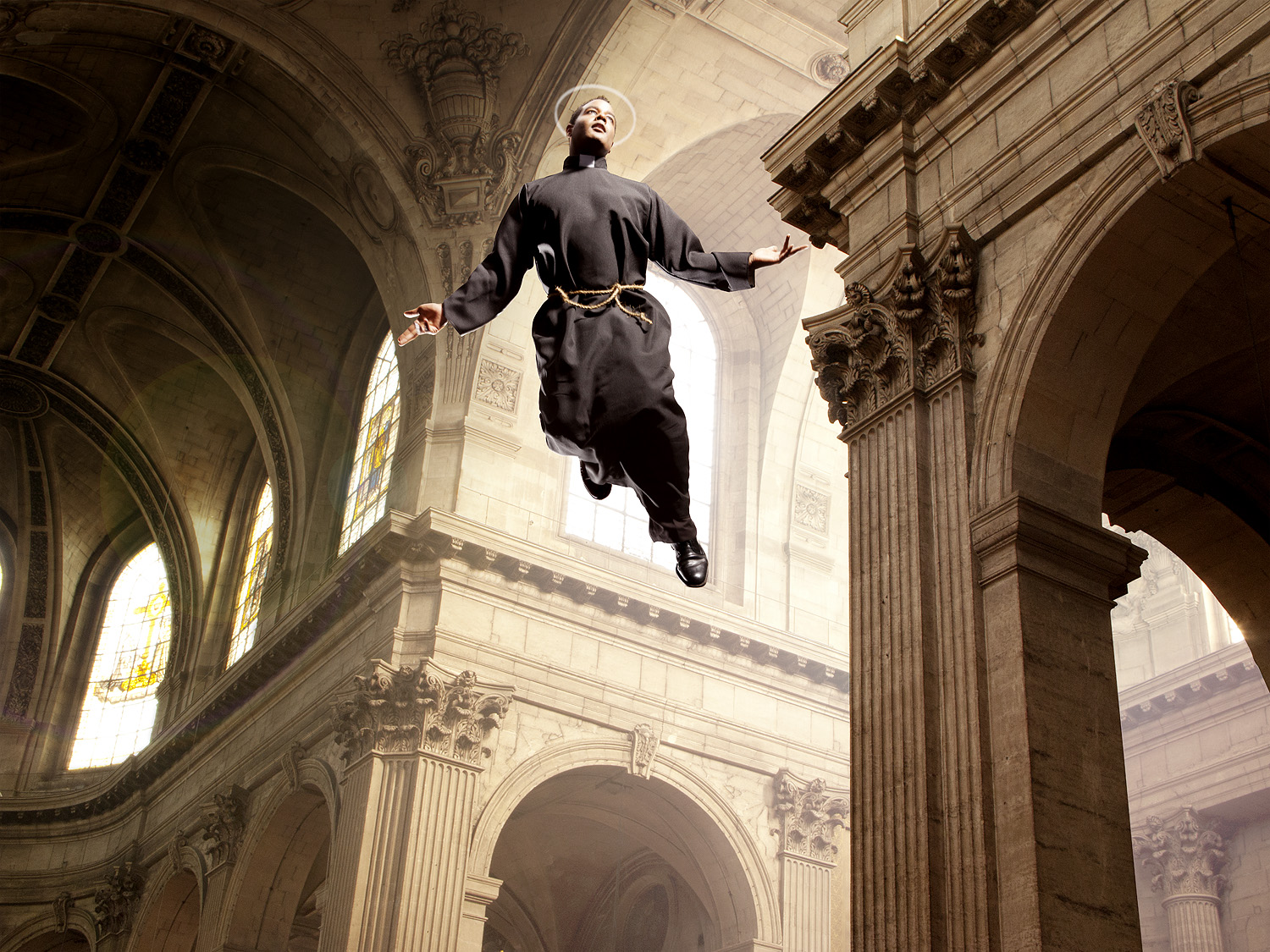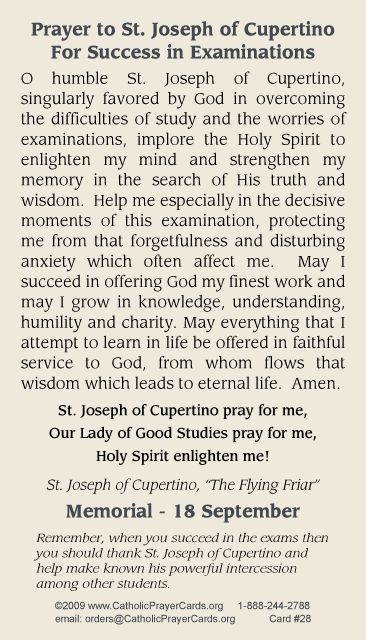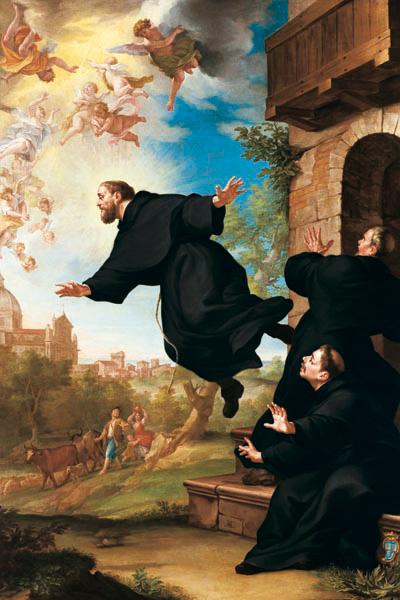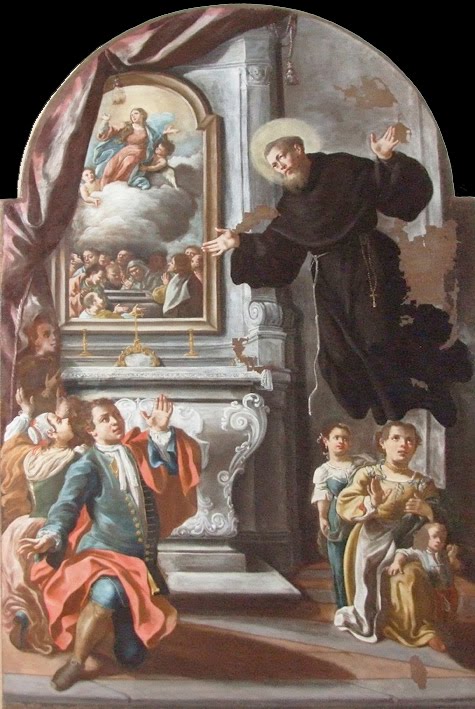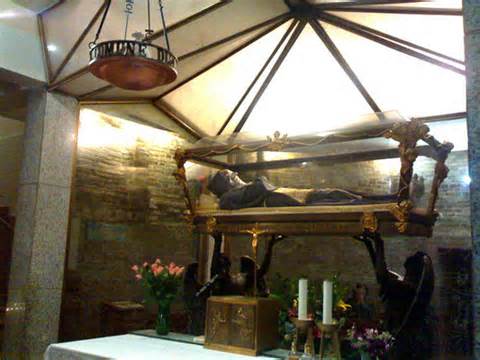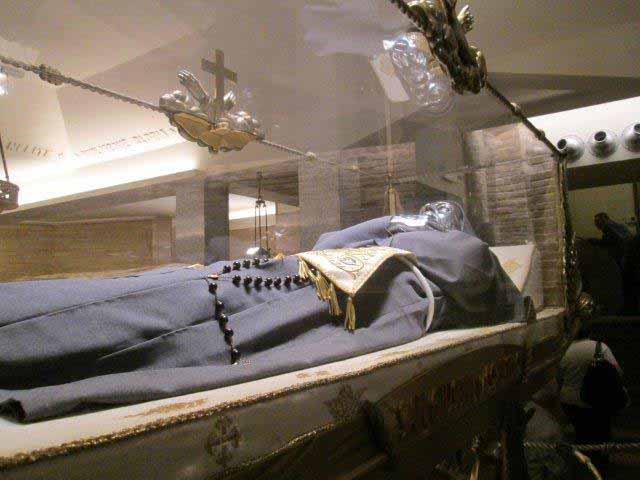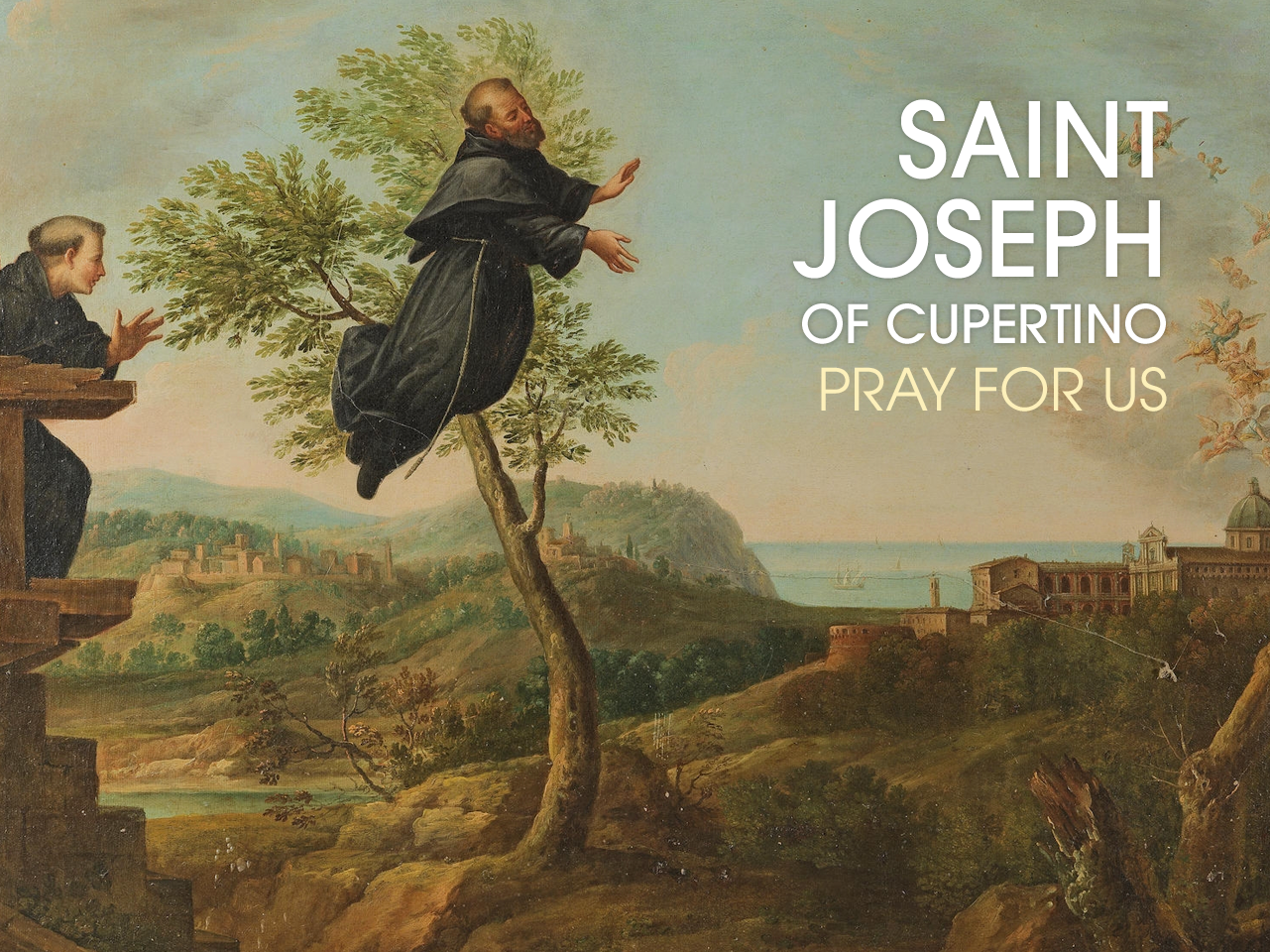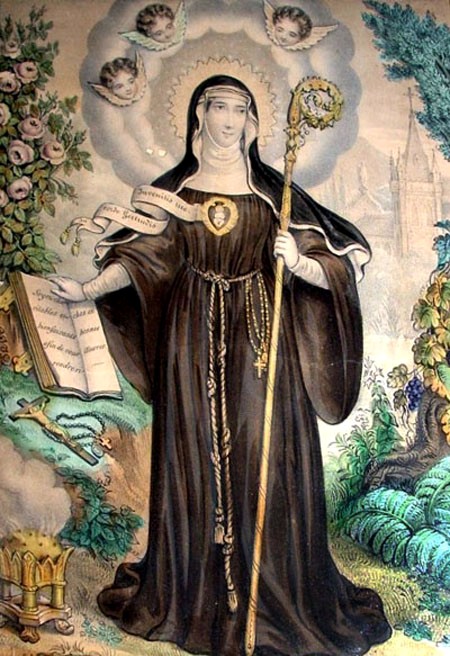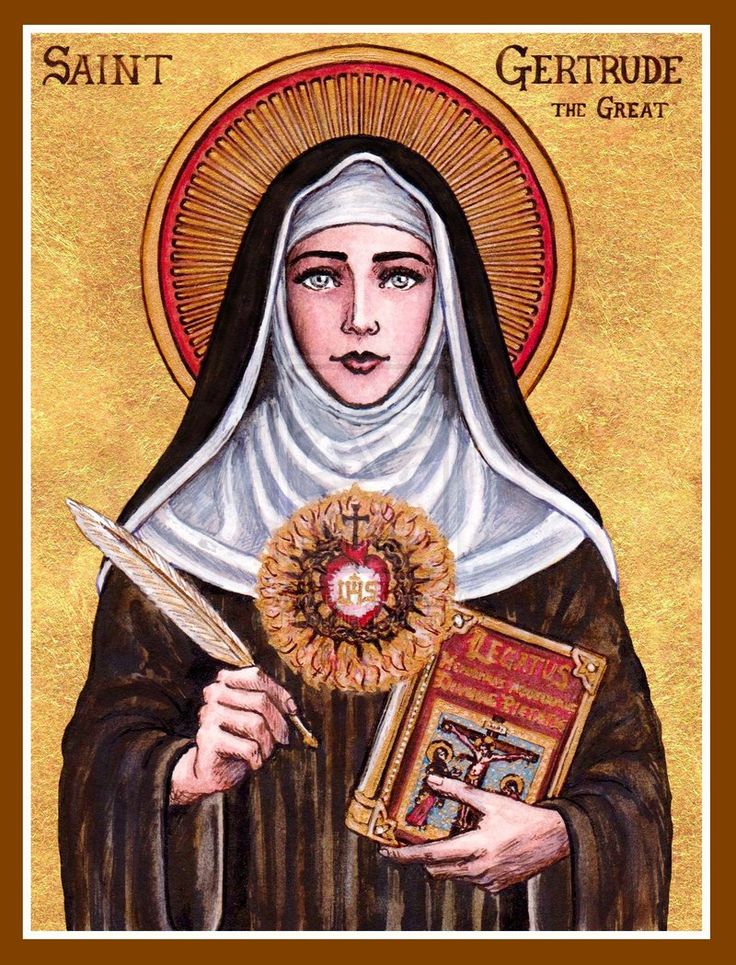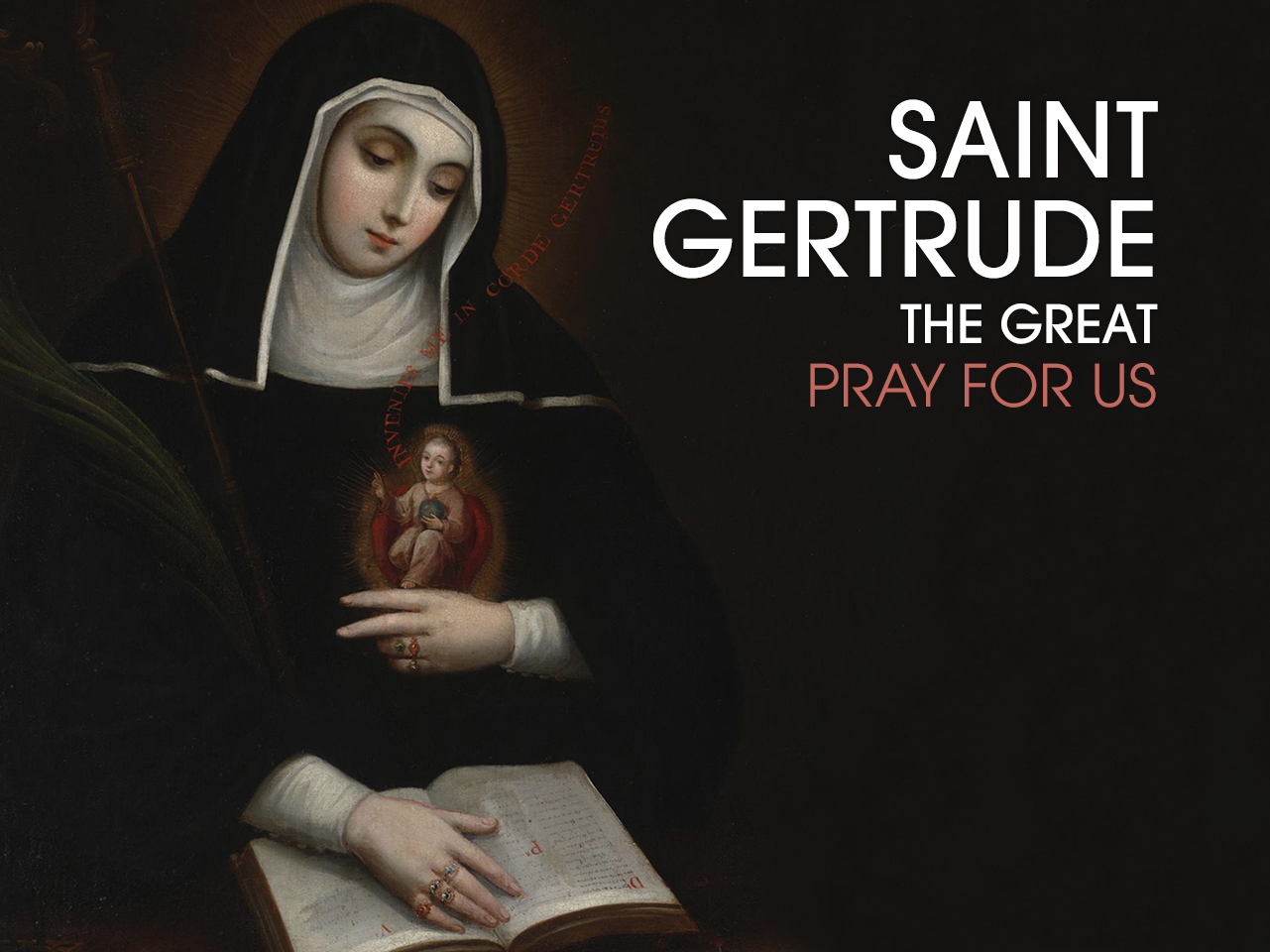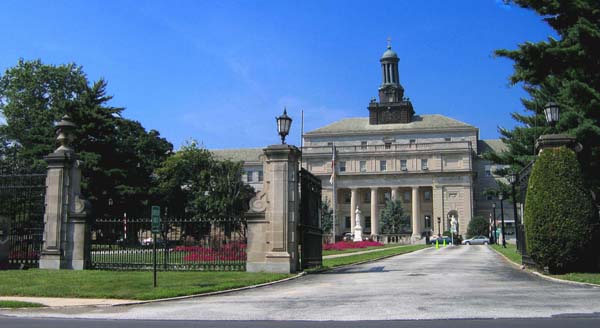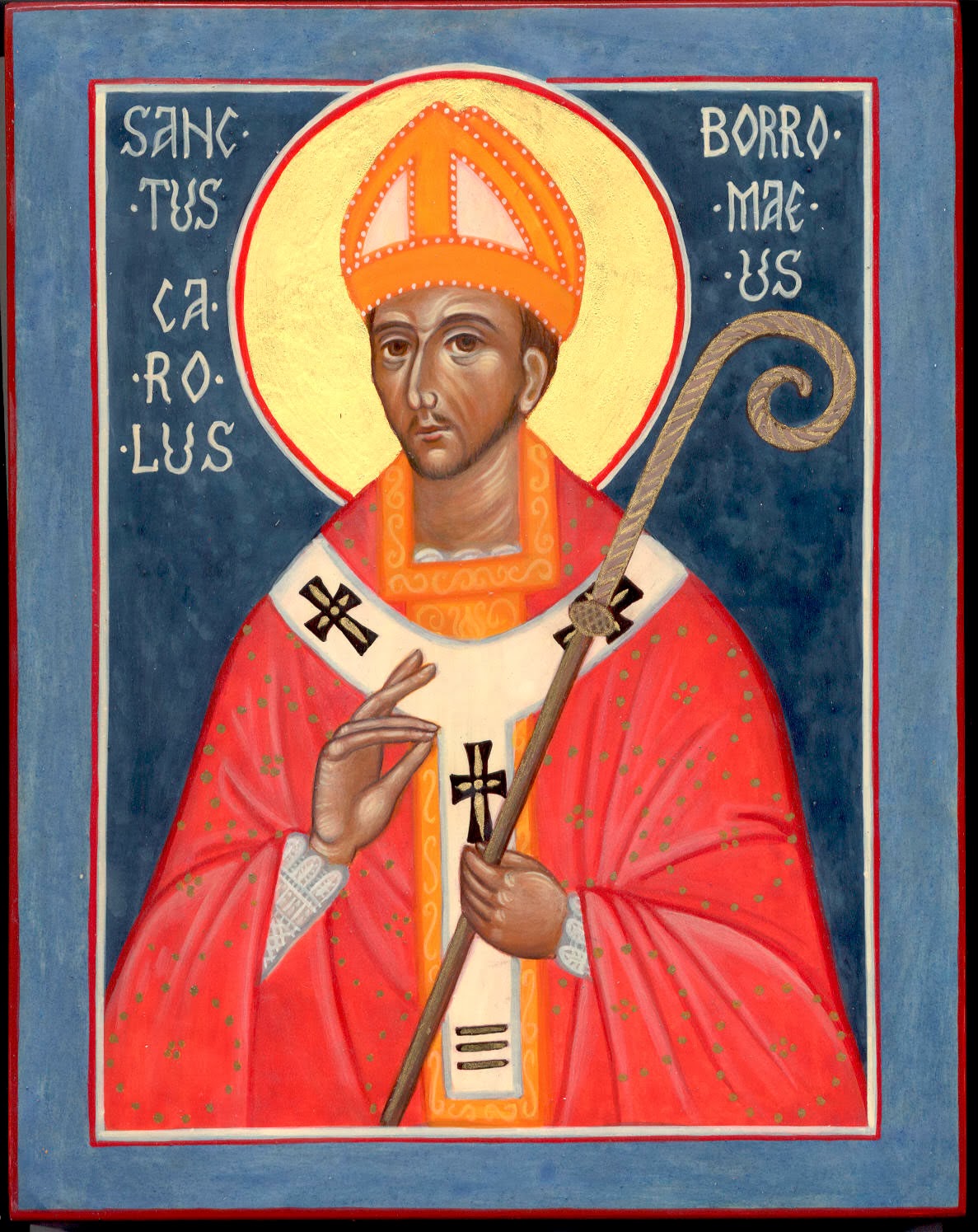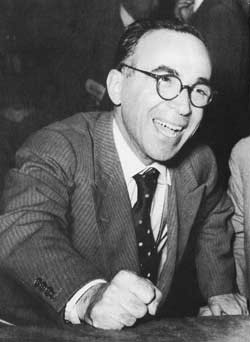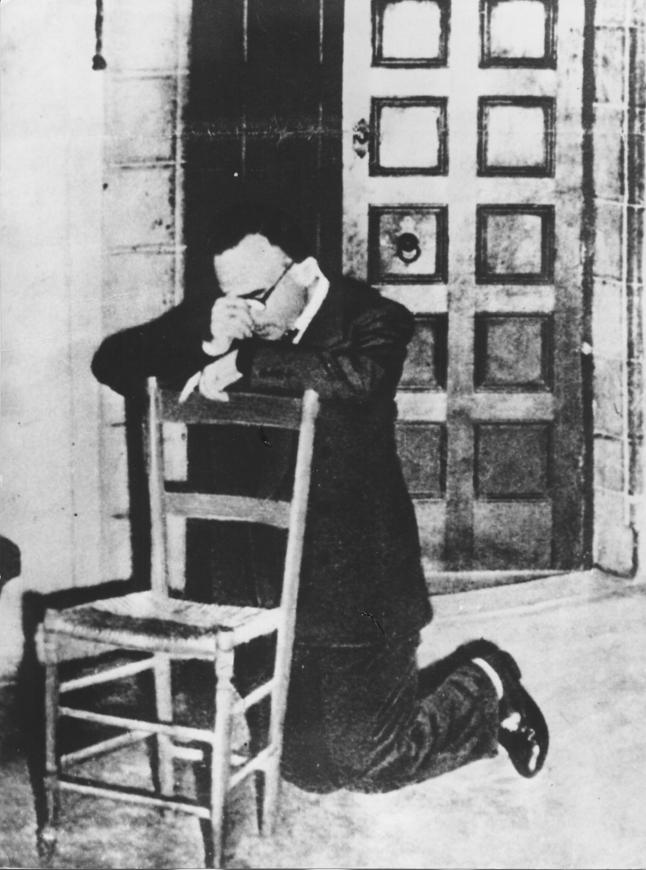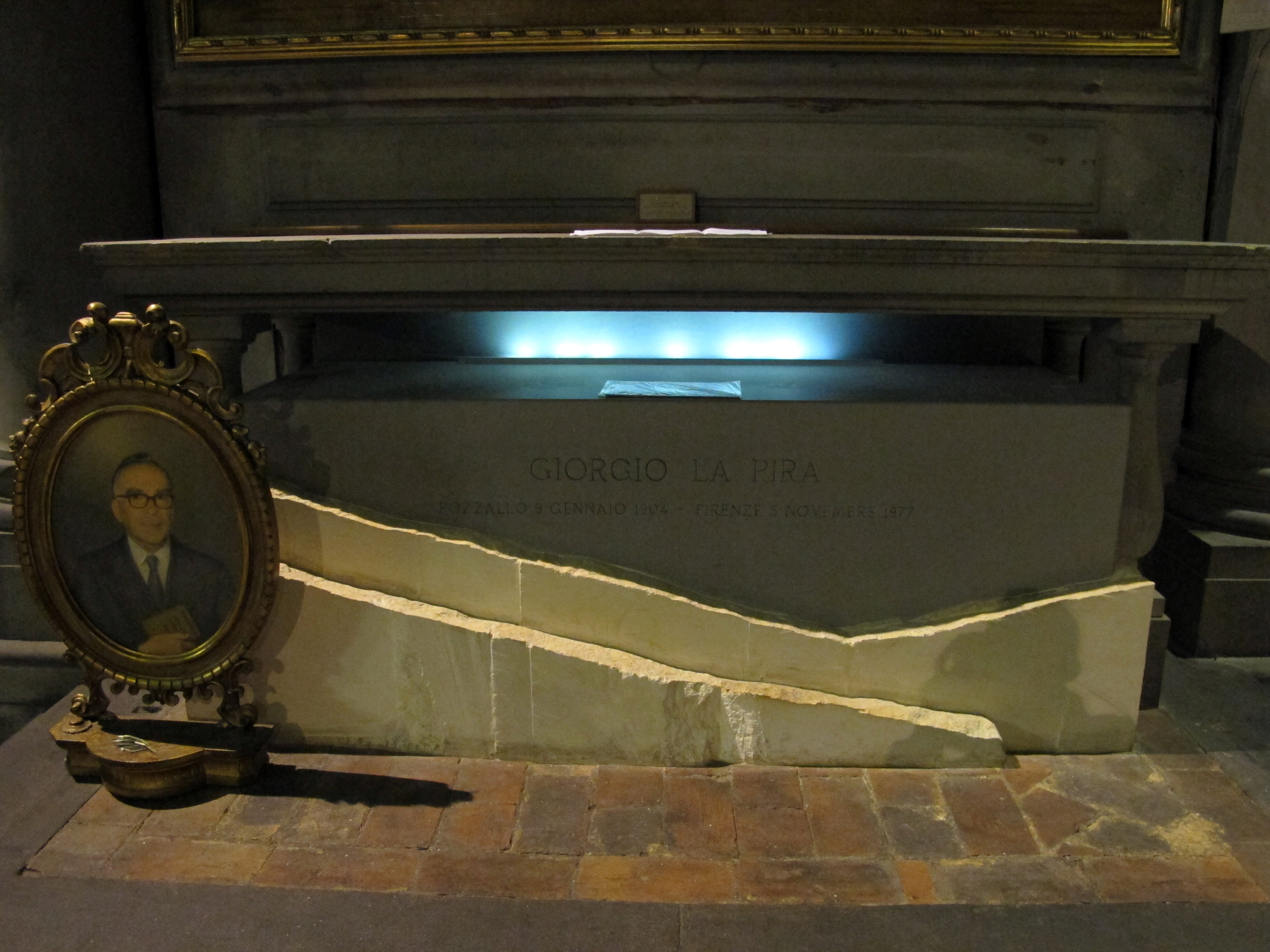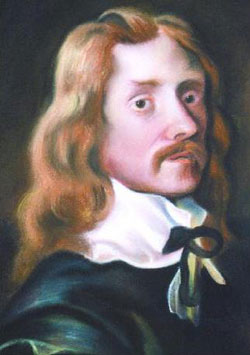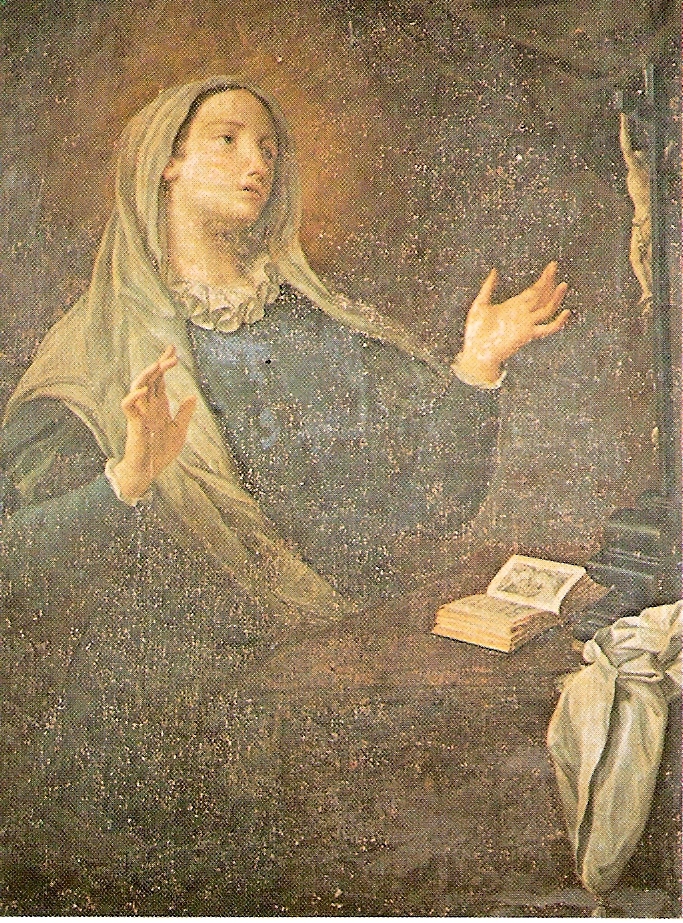
-Saint Catherine of Genoa adoring the Crucified Christ, by Giovanni Agostino Ratti
I LOVE MARRIED SAINTS!!!!! DID I MENTION I LOVE MARRIED SAINTS????!!!! It is NOT any oxymoron, but rather our Christian duty and our obligation due to Almighty God & our spouse.
Born an aristocrat in Genoa in 1447 in the Vico del Filo and baptized as Caterina Fieschi, the youngest of five children, Catherine’s parents were Jacopo Fieschi and Francesca di Negro. Catherine’s family had papal connections. She was related to Pope Innocent V and Pope Adrian V, and Jacopo became Viceroy of Naples. When Catherine was born, many Italian nobles were supporting Renaissance artists and writers. The needs of the poor and the sick were often overshadowed by a hunger for luxury and self-indulgence.
She was known to be pious and prayerful even as a young girl. “Taller than most women, her head well proportioned, her face rather long but singularly beautiful and well shaped, her complexion fair and in the flower of her youth rubicund, her nose long rather than short, her eyes dark and her forehead high and broad; every part of her body was well formed”, Catherine wished to enter a convent when about thirteen, perhaps inspired by her sister, Limbania, who was an Augustinian nun, but the nuns to whom her confessor applied refused her on account of her youth, after which she appears to have put the idea aside without any further attempt.
Her father, Jacopo, passed away shortly after this. Her eldest brother, Giacomo inherited everything. He wishing to resolve differences with the Adorno family, another noble family with whom the Fieschi’s were at odds, and so concocted the idea of marrying Catherine to the Adorno boy, Giuliano, who had returned to Genoa to marry after various military and trading experiences in the Middle East.
Giacomo obtained his mother’s support and found Giuliano more than willing to accept the beautiful, noble and rich bride proposed to him; as for Catherine herself, she would not refuse this cross laid on her at the command of her mother and eldest brother. On 13 January, 1463, at sixteen, Catherine was married to the young Genoese nobleman, Giuliano Adorno. Giuliano was described by a witness of the time to be possessed of a “strange and recalcitrant nature” who wasted his substance on disorderly living including gambling.
The childless marriage turned out wretchedly; Giuliano proved faithless, violent-tempered, and a spendthrift, who made the life of his wife a misery. He was careless and unsuccessful as a husband and provider, often cruel, violent and unfaithful, and reduced them to bankruptcy. Catherine became indifferent to her faith, and fell into a depression.
Details are scanty, but it seems at least clear that Catherine spent the first five years of her marriage in silent, melancholy submission to her husband; and that she then, for another five, turned a little to the world for consolation in her troubles. She tried to find serenity in the distractions of the world. As always, it didn’t work.
Catherine, living with Giacomo in his fine house in the Piazza Sant’ Agnete, at first entirely refused to adopt his worldly ways, and lived “like a hermit”, never going out except to hear Mass. But when she had thus spent five years, she yielded to the remonstrances of her family, and for the next five years practiced a certain commerce with the world, partaking of the pleasures customary among the women of her class but never falling into sin. Increasingly she was irked and wearied by her husband’s lack of spiritual sympathy with her, and by the distractions which kept her from God. Then, ten years after her marriage, she prayed “that for three months He (God) may keep me (Catherine) sick in bed” so that she might escape her marriage, but her prayer went unanswered.
Catherine became so despondent with a profound sense of emptiness and bitterness, she went to talk to her sister, Limbania, at the convent to unload her woes. After listening, Limbania insisted Catherine return the following day and make her confession to the confessor of the nuns at the convent. On 22 March 1473, while making this confession, Catherine was struck down by a vision, the revelation of God’s love and her own sinfulness, and fell into a religious ecstasy; her interior state, and her contact with the Truth she had received in the vision, stayed with her the rest of her life.Suddenly, as she was kneeling down at the confessional, Catherine explained “my heart was wounded by a dart of God’s immense love, and I had a clear vision of my own wretchedness and faults and the Most High Goodness of God. She fell to the ground, all but swooning/fainting”, of this experience she later wrote her heart cried out, “no longer the world, no longer sin”. The confessor was at this moment called away, and when he came back she could speak again, and asked and obtained his leave to postpone her confession. After this revelation occurred she abruptly left the church, without finishing her confession. This marked the beginning of her life of close union with God in prayer.
She hurried home, to shut herself up in the most secluded room in the house, weeping, and for several days she stayed there absorbed by consciousness of her own wretchedness and of God’s mercy in warning her. She had a vision of Our Lord, weighed down by His Cross and covered with blood, and she cried aloud, “O Lord, I will never sin again; if need be, I will make public confession of my sins.” It was an experience she found difficult/nearly impossible to describe. “Oh, Love! Can it be that You have called me with so much love, and revealed to me at one view, what no tongue can describe?…I have no longer either soul or heart; but my soul and my heart are those of my Beloved…”.
She now entered on a life of prayer and penance. She obtained from her husband a promise, which he kept, to live with her as a brother. She made strict rules for herself–to avert her eyes from sights of the world, to speak no useless words, to eat only what was necessary for life, to sleep as little as possible and on a bed in which she put briars and thistles, to wear a rough hair shirt. Every day she spent six hours in prayer. She rigorously mortified her affections and will.
Soon, guided by the Ladies of Mercy, she was devoting herself to the care of the sick poor. In her plain dress she would go through the streets and byways of Genoa, looking for poor people who were ill, and when she found them she tended them and washed and mended their filthy rags. Often she visited the hospital of St. Lazarus, which harbored incurables so diseased as to be horrible to the sight and smell, many of them embittered. In Catherine they aroused not disgust but charity and love; she met their insults with unfailing gentleness.
From the time of her conversion she hungered insatiably for the Holy Eucharist, and the priests admitted her to the privilege, very rare in that period, of daily communion. Once upon receiving Communion, Catherine gazed towards her Lord and said, “O Lord, perhaps Thou wouldst draw me to Thee by this fragrance? I do not desire it; I desire nothing but Thee, and Thee wholly; Thou knowest, that from the beginning, I have asked of Thee the grace that I might never see visions, nor receive external consolations, for so clearly do I perceive Thy goodness, that I do not seem to walk by faith but by a true and heartfelt experience.”
For twenty-three years, beginning in the third year after her conversion, she fasted completely throughout Lent and Advent, except that at long intervals she drank a glass of water mixed with salt and vinegar to remind herself of the drink offered to Our Lord on the cross, and during these fasts she enjoyed exceptional health and vigor. For twenty-five years after her conversion she had no spiritual director except Our Lord Himself. Then, when she had fallen into the illness which afflicted the last ten years of her life, she felt the need for human help, and a priest named Fr. Cattaneo Marabotto, who had a position of authority in the hospital in which she was then working, became her confessor. To him she explained her states, past and present, and he compiled the “Memoirs”.
The time came when the directors of the great hospital in Genoa asked Catherine to superintend the care of the sick in this institution. She accepted, and hired near the hospital a poor house in which she and her husband lived out the rest of their days. Her prayers were still long and regular and her raptures frequent, but she so arranged that neither her devotions nor her ecstasies interfered with her care of the sick. Although she was humbly submissive even to the hospital servants, the directors saw the value of her work and appointed her rector of the hospital with unlimited powers.In 1497 she nursed her husband through his last illness. In his will he extolled her virtues and left her all his possessions. After Giuliano’s death, her life was devoted to her relationship with God, through “interior inspiration” alone. She used no other and needed no other forms of prayer.
When Catherine was fifty-three, she fell ill. Worn out by her life of ecstasies, her burning love for God, labor for her fellow creatures and her privations; during her last ten years on earth she suffered much. She died in 1510, worn out with labors of body and soul. Her death had been slow with many days of pain and suffering as she experienced visions and wavered between life and death.
In 1551, 41 years after her death, a book about her life and teaching was published, entitled “Libro de la vita mirabile et dottrina santa de la Beata Caterinetta de Genoa”. This is the source of her “Dialogues on the Soul and the Body” and her “Treatise on Purgatory”. It is her writings that have continued her fame today; during her canonization inquiry, the Holy Office announced that her writings alone were enough to prove her sanctity. Her writings also became sources of inspiration for other religious leaders such as Saints Robert Bellarmine and Francis de Sales and Cardinal Henry Edward Manning.
Catherine wrote about purgatory which, she said, begins on earth for souls open to God. Life with God in heaven is a continuation and perfection of the life with God begun on earth. For Catherine, purgatory was not another physical place to go to atone for one’s sins, but rather, an interior cleansing. She speaks of the soul’s purification onto complete union with God. “The soul”, Catherine says, “presents itself to God still bound to the desires and suffering that derive from sin and this makes it impossible for it to enjoy the beatific vision of God”. Catherine asserts that God is so pure and holy that a soul stained by sin cannot behold/be in the beatific vision, the presence of the Divine Majesty. The soul is aware of the immense love and perfect justice of God and consequently suffers for having failed to respond in a correct and perfect way to this love; and love for God itself becomes a flame, love itself cleanses the soul from the residue of sin. In writing about purgatory, Catherine reminds us of a fundamental truth of faith that becomes for us an invitation to pray for the deceased so that they may attain the beatific vision of God in the Communion of Saints (cf. Catechism of the Catholic Church, n. 1032).
St Catherine of Genoa is patroness of Brides, Childless People, Difficult Marriages, People Ridiculed For Their Piety, Victims Of Adultery, and Widows, among other causes.
“We should not wish for anything but what comes to us from moment to moment, exercising ourselves none the less for good. For he who would not thus exercise himself, and await what God sends, would tempt God. When we have done what good we can, let us accept all that happens to us by Our Lord’s ordinance, and let us unite ourselves to it by our will. Who tastes what it is to rest in union with God will seem to himself to have won to Paradise even in this life.” -St Catherine of Genoa
“It remains for us to pray the Lord, of His great goodness and by the intercession of this glorious Seraphim, to give us His love abundantly, that we may not cease to grow in virtue, and may at last win to eternal beatitude with God who lives and reigns for ever and ever.” –St Catherine of Genoa
“Since I began to love, love has never forsaken me. It has ever grown to its own fullness within my innermost heart.” –St Catherine of Genoa
“If it were possible for me to suffer as much as all the martyrs have suffered, and even Hell itself, for the love of God, and in order to make satisfaction to Him, it would be after all only a sort of injury to God, in comparison with the love and goodness with which He has created, and redeemed, and, in a special manner, called me. For man, unassisted by God’s grace, is even worse than the devil, because the devil is a spirit without a body, while man, without the grace of God, is a devil incarnate. Man has a free will, which, according to the ordination of God, is in nowise bound, so that he can do all the evil that he wills; to the devil, this is impossible, since he can act only by the divine permission; and when man surrenders to him his evil will, the devil employs it, as the instrument of his temptation.”-St Catherine of Genoa
“The souls in Purgatory see all things, not in themselves, nor by themselves, but as they are in God, on whom they are more intent than on their own sufferings. . . . For the least vision they have of God overbalances all woes and all joys that can be conceived. Yet their joy in God does by no means abate their pain. . . . This process of purification to which I see the souls in Purgatory, subjected, I feel within myself.” -St Catherine of Genoa“I see that whatever is good in myself, in any other creature, or in the saints, is truly from God; if, on the other hand, I do any thing evil, it is I alone who do it, nor can I charge the blame of it upon the devil or upon any other creature; it is purely the work of my own will, inclination, pride, selfishness, sensuality, and other evil dispositions, without the help of God I should never do any good thing. So sure am I of this, that if all the angels of heaven were to tell me I have something good in me, I should not believe them. So long as any one can speak of divine things, enjoy and understand them, remember and desire them, he has not yet arrived in port; yet there are ways and means to guide him thither. But the creature can know nothing but what God gives him to know from day to day, nor can he comprehend beyond this, and at each instant remains satisfied with what he receives. If the creature knew the height to which God is prepared to raise him in this life, he would never rest, but on the contrary would feel a certain craving, a vehement desire to reach quickly that ultimate perfection, and would think himself in Hell until he had obtained it.”-St Catherine of Genoa
“If it were given to a man to see virtue’s reward in the next world, he would occupy his intellect, memory and will in nothing but good works, careless of danger or fatigue.” – St Catherine of Genoa
“We must not wish anything other than what happens from moment to moment, all the while, however, exercising ourselves in goodness. And to refuse to exercise oneself in goodness, and to insist upon simply awaiting what God might send, would be simply to tempt God.”
–St. Catherine of Genoa
“I see clearly with the interior eye, that the sweet God loves with a pure love the creature that He has created, and has a hatred for nothing but sin, which is more opposed to Him than can be thought or imagined.”
–St. Catherine of Genoa
“The fullness of joy is to behold God in everything.” -St. Catherine of Genoa
“The greatest suffering of the souls in purgatory, it seems to me, is the awareness that something in them displeases God, that they have deliberately gone against His great goodness. I can also see that the divine essence is so pure and light-filled—much more than we can imagine—that the soul that has but the slightest imperfection would rather throw itself into a thousand hells than appear thus before the divine presence.”
—St. Catherine of Genoa
Shortly before her death Catherine told her goddaughter: “Tomasina! Jesus in your heart! Eternity in your mind! The will of God in all your actions! But above all, love, God’s love, entire love!”
“Through the words of this great Saint and the Gift that God had Graced her, we have gained a better understanding of the graphic damage that sin can do to a soul and also how the soul can be restored back to God’s Loving embrace through participation of the Sacraments. We also understand how God can transform a soul to be a divine reflection of Himself when the soul surrenders itself to the Triune Spirit. And through the works of Saint Catherine we also understand Purgatory and the Holy Souls who wait to be released into Heaven by our prayers and penances and when we offer up a Mass for the repose of their soul as these Holy souls endure the purgation of Purgatory, as they thirst to be re-united with God in Heaven. May we reflect deeply on the messages of Saint Catherine of Genoa and how God illuminated her soul so as to instruct the faithful.” – a commentator on St Catherine of Genoa
“The purifying fires draw them ever upward and closer to God.”
—Catherine of Genoa
Love,
Matthew
Sep 18 – St Joseph of Cupertino, (1603-1663), The Flying Friar
The Flying Nun you’ve probably heard of. (Sally Field/Sister Bertrille, ora pro nobis!) And, school has begun. And, school is hard these days. There is more to learn than ever and more than ever riding on success. Even adults have to go back to school these days to remain competitive.
That is not intended to pressure students any more than they already pressure themselves, the successful ones and even the ones that try as hard as they can but are not as successful. Students lack adult perspective, by definition. Unless successful at or preferably beyond their and their guardians’ expectations, they do not understand yet/have the maturity to embrace failure as a means of personal growth and realize its value, and even be thankful for it/rejoice in it for the new perspectives it brings and the death of the old way of seeing and thinking. It brings in life sweet revelations and humility. I, obviously, require MUCH more! 🙂 Deo gratias!
The young need our support and encouragement always. It’s tough out there for the young. They are not permitted the joy and luxury, to which all young persons should be, of being young very long these days. What a shame for them and for us. The young refresh us. Take us back to happier days of simpler moments in our lives/redeem us; most of us. (cf Mt 18:3)
Although, not regular supplicants, the most unspiritual student, even non-Catholics, have been known to offer the occasional prayer during examination or other stressful scholarly moment to St Thomas Aquinas, or in this case, St Joseph of Cupertino. Couldn’t hurt, right? 🙂
Joseph, as a child, was noticed to be remarkably unclever, dull, dimwitted. We might consider him today mentally disabled. But, God writes straight with crooked lines (~ancient Portugese proverb).
Born Giuseppe Maria Desa in Cupertino, Apulia, June 17, 1603, Joseph’s father, Felice Desa, was a poor carpenter in the fortified town of Cupertino, located in the heel of the boot of Italy, on the Apulian peninsula within the then Kingdom of Naples. He died before the boy was born.
Known locally as a charitable man, Felice often guaranteed the debts of his poorer neighbors, often driving himself into debt as a result. Felice died prior to Joseph’s birth, leaving his wife Francesca Panara destitute and pregnant with the future saint.
Creditors drove his mother, Francesca, from her home, sold to pay Felice’s debts. Because of this, Joseph was born in the stable behind their home. (Sound familiar? Now WHERE have I heard that before? Think. Think. Think. Nope. Nothing.)
Starting at age eight, he became prone to ecstatic visions that left him gaping and staring into space. His childhood detractors gave him the pejorative nickname, “the Gaper.” He had a hot temper, which his strict mother worked to overcome. Francesca became hardened by her circumstances, and everything became Joseph’s fault.
Joseph knew he was not as quick as the others, or athletic, or comely. Other children were praised. Joseph was not. Other children were given presents or nice clothes. Joseph was not. Absent-minded, awkward, nervous, sudden noises such as the ringing of a church bell would cause Joseph to drop all his books on the floor. He even had trouble making friends. He couldn’t carry on a conversation or tell a story. His very sentences would stop in the middle because he could not find the right words, no matter how he tried. Joseph was something of a trial, to even those who tried to love him. Nobody wanted Joseph. He learned this early on. He began to think of himself as a dumb mule, a jackass. When called to account, his only response would be, “I forgot.”
Apprenticed to a shoemaker, Joseph made a very poor cobbler, but he kept trying. At age 17 Joseph applied for admittance to the Friars Minor Conventuals, but was refused due to his lack of education. He applied to the Capuchins, was accepted as a lay-brother in 1620, but his ecstasies made him unsuitable for work. Often he was taken in ecstasy and, oblivious of what he was doing, he would drop the food or break the dishes and trays. As a penance, bits of broken plates were fastened to his habit as a humiliation and reminder not to do the same again. Eventually, he was dismissed. His habit taken from him, he was told to go. It was the hardest day of his life. When they took his habit, it was like their taking his skin from him, he said. Now what was he going to do? Could he do? Joseph was despondent.
That was not the end of his troubles. When he had recovered from his stupor on the road outside the friary, he found he had lost some of his lay clothes. He was without a hat; he had no boots or stockings, his coat was moth-eaten and worn. Such a sorry sight did he appear, that as he passed a stable down the lane some dogs rushed out on him, and tore what remained of his rags to still worse tatters.
Having escaped from the dogs, poor Joseph trudged along, wondering what next would happen. He passed some shepherds tending sheep. They took him for a dangerous character. When questioned he could give no account of himself and they were about to give him a beating; fortunately one of them had a little pity, and persuaded them to let him go free. But it was only to pass from one trouble into another. Scarcely had he gone a little further down the road when a nobleman on horseback met him. The latter could see in Joseph nothing but a suspicious tramp who had no business in those parts, and thought to hand him over to the police; only when, after examining him, he had come to the conclusion that Joseph was too stupid to be harmful did he let him go.
At last, torn and battered and hungry, Joseph came to a village where one of his uncles lived. He was a prosperous tradesman there, with a thriving little shop of his own; and Joseph hoped he would find with him some kind of comfort, perhaps another start in life. But he was sadly disappointed.
Nephews of Joseph’s type, even at their best, are not always welcome to prosperous uncles, much less when they turn up unexpectedly, with scarcely a rag on their backs. Joseph’s uncle was no better and no worse than others. He looked at the poor lad who stood before him, soiling his clean shop floor with his dirty, bare feet, disgracing himself and his house with his rags, and he was just a little ashamed to own him as a nephew.
Evidently, he said to himself, the boy had inherited his father’s improvident ways, and would come to nothing good. He was already well on the road to ruin; to help him would only make him worse. Besides, Joseph’s father already owed him money; how, then, could he be expected to do anything for the son?
So instead of offering him assistance, Joseph’s uncle turned upon him; blamed him for his sorry plight, which, he said, he must have brought upon himself; railed at him because of his father’s debts, which such a son could only increase; finally pushed him into the street, without a coin to help him on his way. There was nothing to be done; he must move on; nobody wanted Joseph.
At last he reached his native town, and made for his mother’s cottage. During Joseph’s absence, things had gone no better than before. He came to the door in fear and trembling, remembering well how his mother had long since tired of his presence. Still he would venture; it was the only place left where he might hope for a shelter and he must try. He opened the door and looked in; inside he found his mother, busy about her little hovel. Weary and footsore, hungry and miserable, no longer able to stand, he fell on the floor at his mother’s feet; he could not speak a word, though his glistening eyes as he looked up at her were eloquent.
But they failed to soften his mother. She had gone through hard times enough and was unprepared for more. What? Had he come back to burden them, now when things were worse than ever? And further disgraced, besides, for had he not been expelled from a monastery? How the neighbors would talk, and scorn the mother for having such a son; an unfrocked friar, a ne’er-do- well, a common tramp, and that at an age when other youths were earning an honest livelihood! She could restrain herself no longer. As he lay at her feet she rounded on him.
“You have been expelled from a house of religious,” she cried. “You have brought shame upon us all. You are good for nothing. We have nothing for you here. Go away; go to prison, go to sea, go anywhere; if you stay here there is nothing for you but to starve.”
But she was not content with only words. She had a brother who was a Franciscan, holding some sort of office. In high dudgeon, she went off to him, and gave him a piece of her mind about the way his Order had dismissed her son, and put him again on her hands. She appealed to him to have him taken back, in any capacity they liked; so long as she was rid of him, they could do with him what they chose. But as for readmission, the good Franciscans were immovable. Joseph had been examined before, and had been declared unsuitable; he had been tried, and had been found wanting; the most they could do was to give him the habit of the Third Order, and employ him somewhere as a servant. He was appointed to the stable; there he could do little harm. Joseph was made the keeper of the monastery mule.
And then a change came. Joseph set about his task since it was now clear that he could never be a Franciscan, at least he could be their servant. He said not a word in complaint; what had he to complain of? He told himself that all this was only what he might have expected; being what he was, he might consider himself fortunate to find any job at all entrusted to him. He asked for no relief; he took the clothes and the food they chose to give him; he slept on a plank in the stable, it was good enough for him. What was more, in spite of his dullness, perhaps because of it, Joseph had by nature a merry heart. However great his troubles, the moment a gleam of sunshine shone upon him he would be merry and laugh. The troubles were only his desert and were to be expected; when brighter times came he enjoyed them as one who had received a consolation wholly unlooked for, and wholly undeserved.
Gradually this became noticed. Friars would go down to the stable for one reason or another, and always Joseph was there to welcome them, apparently as happy as a lord. It was seen how little he thought of himself, how glad he was to serve; since he could not be a begging friar, sometimes in his free moments he went out and begged for them on his own account. His lightheartedness was contagious; his kindly tongue made men trust him; it was noticed how he was welcomed among the poorest of the poor, who saw better than others the man behind all his oddities. He might make a Franciscan after all. The matter was discussed in the community chapter; his case was sent up to a provincial council for favorable consideration; it was decided, not without some qualms, to give him yet another trial.
In this way Joseph was once more admitted to the Order, but what was to be done with him then? His superiors set him to his studies, in the hope that he might learn enough to be ordained, but the effort seemed hopeless. With all his good intentions he learnt to read with the greatest difficulty, and, says his biographer, his writing was worse. He could never expound a Sunday Gospel in a way to satisfy his professors; one only text seemed to take hold of him, and on that he could always be eloquent; speaking from knowledge which was not found in books. It was a text of St. Luke (xi, 27): “Beatus venter qui Te portavit.”
Minor Orders in those days were easily conferred, and even the subdiaconate; but for the diaconate and the priesthood a special examination had to be passed, in presence of the bishop himself. As a matter of form, but with no hope of success, Joseph was sent up to meet his fate. The bishop opened the New Testament at haphazard; his eye fell upon the text “Beatus venter qui Te portavit,” and he asked Joseph to discourse upon it. To the surprise of everyone present Joseph began, and it seemed as if he would never end; he might have been a Master in Theology lost in a favorite theme. There could be no question about his being given the diaconate.
When it was a question of the priesthood, the first candidates did so well that the remainder of the candidates, Joseph among them, were passed without examination and Joseph was ordained a priest in 1628. Deo gratias!
His virtues were such that he became a cleric at 22, a priest at 25, on March 4, 1628. Joseph still had little education, could barely read or write, but received such a gift of spiritual knowledge and discernment that he could solve intricate questions. During this period of his life, the spiritual consolations he had enjoyed since his childhood abandoned him. Later he wrote to a friend about that difficult time: “I complained a lot to God about God. I had left everything for Him, and He, instead of consoling me, delivered me to mortal anguish.”
He continued: “One day, when I was weeping and wailing in my cell, a religious knocked on my door. I did not answer, but he entered my room and said: ‘Friar Joseph, how are you?’
“‘I am here to serve you,’ I answered.
“‘I thought you did not have a habit,’ he continued.
“‘Yes, I have one, but it is falling apart,’ I responded.
“Then, the unknown religious gave me a habit, and when I put it on, all my despair disappeared immediately. No one ever knew who that religious was.”
There were many, by this time, besides the very poor who had come to realize the wonderful simplicity and selflessness of Joseph, hidden beneath his dullness and odd ways; a few had discovered the secret of his abstractedness, when he would lose himself in the labyrinth of God.
Nevertheless he remained a trial, especially to the practical-minded; to the end of his life he had to endure from them many a scolding. Often enough he would go out begging for the brethren, and would come home with his sack full, but without a sandal, or his girdle, or his rosary, or sometimes parts of his habit. His friends among the poor had taken them for keepsakes, and Joseph had been utterly unaware that they had gone. He was told that the convent could not afford to give him new clothes every day. “Oh! Father,” was his answer, “then don’t let me go out any more; never let me go out any more. Leave me alone in my cell to vegetate; it is all I can do.”
For indeed, as we have seen, Joseph had no delusions about himself; and his ordination did not make him think differently. True he was a priest, but everybody knew how he had received the priesthood. He could assume no airs on that account.
On the contrary, knowing what he was, he could only act accordingly. In spite of his priestly office, Joseph could only live the life he had lived before. He would slip down to the kitchen and wash up the dishes; he would sweep the corridors and dormitories; he would look out for the dirtiest work that others shirked, and would do it; when building was going on in the convent he would carry up the stones and mortar; if anyone protested, declaring that such work did not become a priest, Joseph would only reply to them: “What else can Brother Ass do?”, a name given him by his brothers in religion.
But now began that wonderful experience the like of which is scarcely to be paralleled in the life of any other saint. It was first in his prayer. Joseph’s absent-mindedness, from his childhood upwards, had not been only a natural weakness, it was due, in great part, to a wonderful gift of seeing God and the supernatural in everything about him, and he would become lost in the wonder of it all. Now when he was a friar, and a priest besides, the vision grew stronger; it seemed easier for him to see God indwelling in His creation than the material creation in which he dwelt. The realization became to him so vivid, so engrossing, that he would spend whole days lost in its fascination, and only an order from his superiors could bring him back to earth.
Joseph’s visions and ecstasies would come suddenly upon him anywhere; as it were from out of space the eyes of God would look at him, or on the face of nature the hand of God would be seen at work, disposing all things.
Joseph would stand still, exactly as the vision caught him, fixed as a statue, insensible as a stone, and nothing could move him. The brethren would use pins and burning embers to recall him to his senses, but nothing could he feel. When he did revive and saw what had happened, he would call these visitations fits of giddiness, and ask them not to burn him again. Once a prelate, who had come to see him on some business, noticed that his hands were covered with sores. Joseph could not hide them, nor could he hide the truth, but he had an explanation ready.
“See, Father, what the brethren have to do to me when the fits of giddiness come on. They have to burn my hands, they have to cut my fingers, that is what they have to do.” And Joseph laughed, as he so often laughed; but we suspect that it was laughter keeping back tears.
His life became a series of visions and ecstasies, which could be triggered any time or place by the sound of a church bell, church music, the mention of the name of God or of the Blessed Virgin or of a saint, any event in the life of Christ, the sacred Passion, a holy picture, the thought of the glory in heaven, etc. Yelling, beating, pinching, burning, piercing with needles – none of this would bring him from his trances, but he would return to the world on hearing the voice of his superior in the order.
On October 4, 1630, the town of Cupertino held a procession on the feast day of Saint Francis of Assisi. Joseph was assisting in the procession when he suddenly soared into the sky, where he remained hovering over the crowd.
When he descended and realized what had happened, he became so embarrassed that he fled to his mother’s house and hid. This was the first of many flights, which soon earned him the nickname “The Flying Saint”.
Joseph’s life changed dramatically after this incident. His flights continued and came with increasing frequency. His superiors, alarmed at his lack of control, forbade him from community exercises, believing he would cause too great a distraction for the friary. For the fact was, Joseph could not contain himself. On hearing the names of Jesus or Mary, the singing of hymns during the feast of St. Francis, or while praying at Mass, he would go into a dazed state and soar into the air, remaining there until a superior commanded him under obedience to revive.
In the refectory, during a meal, Joseph would suddenly rise from the ground with a dish of food in his hands, much to the alarm of the brethren at table. When he was out in the country begging, suddenly he would fly into a tree. Once when some workmen were laboring to plant a huge stone cross in its socket, Joseph rose above them, took up the cross and placed it in the socket for them.
So concerned were Joseph’s brethren, they ordered him to be examined by the General of the Order. The Minister General could find no fault in Joseph. He took Joseph to see the Pope.
Joseph’s most famous flight allegedly occurred during the papal audience before Pope Urban VIII. When he bent down to kiss the Pope’s feet, he was suddenly filled with reverence for Christ’s Vicar on earth, and was lifted up into the air. Only when the Minister General of the Order, who was part of the audience, ordered him down was Joseph able to return to the floor.
Among other paranormal events associated with Joseph, he is said to have possessed the gift of healing. It is reported he once cured a girl who was suffering from a severe case of measles. Another story holds that an entire community suffering from a drought asked Joseph to pray for rain, which he did with success. He also dedicated himself to improving the spiritual lives of his fellow friars.
Not all of the friars whom Joseph lived with were well disposed towards him. Some superiors would scold Joseph for not accepting money and gifts offered to him for curing people, especially when they were members of the nobility. He would also find himself in trouble for returning home with a torn habit as a result of the people seeking relics who regarded him as a prophet and a saint.
Perhaps the most difficult time came when Joseph was the subject of an investigation by the Inquisition at Naples. Msgr. Joseph Palamolla accused Joseph of attracting undue attention with his “flights”, and claiming to perform miracles. On October 21, 1638, Joseph was summoned to appear before the Inquisition and, when he arrived, he was detained for several weeks. Joseph was eventually released when the judges found no fault with him.
Nervous and concerned about letting Joseph wander about at liberty with such powers and how that might upset ordered society, wanting to keep all of this hush-hush, Joseph’s superiors ordered him into seclusion. “Have I to go to prison?” he asked, as if he had been condemned. But in an instant he recovered. He knelt down and kissed the Inquisitor’s feet; then got into the carriage, smiling as usual as if nothing had happened.
After being cleared by the Inquisition, Joseph was sent to the Sacro Convento in Assisi. Though Joseph was happy to be close to the tomb of St Francis, he experienced a certain spiritual dryness. His flights came to a halt during this period.
Two years after his arrival at the Sacro Convento, Joseph was made an honorary citizen of Assisi and a full member of the Franciscan community. He lived in Assisi for another nine years. During this period Joseph was sought after by people (including ministers general, provincials, bishops, cardinals, knights and secular princes) who wanted to experience his divine consolation. He was happy to oblige, but the isolation of exile left him repressed. Believers were able to seek him out, but he was not allowed to preach or hear confessions, nor to join in the processions and festivities of feast days.
Over time, Joseph attracted a huge following. To stop this, Pope Innocent X decided to move Joseph from Assisi and place him in a secret location under the jurisdiction of the Capuchin friars in Pietrarubbia. Joseph was placed under strict orders to avoid writing letters, but he continued to attract throngs of people. This soon forced him to be moved to another location, this time to Fossombrone, which had little more success.
The ordeal finally ended when Pope Innocent X died, and the Conventual friars asked the newly elected Pope Alexander VIII to release Joseph from his exile and return him to Assisi. Alexander declined, and instead released Joseph to the friary in Osimo, where the Pope’s nephew was the local bishop. There, Joseph was ordered to live in seclusion and not speak to anyone except the Bishop, the Vicar General of the Order, his fellow friars, and, in case of a health crisis, a doctor. Joseph endured his ordeal with great patience. It is reported he did not even complain when a brother-cook neglected to bring him any food to his room for two days; this dull man whom no one could teach, and no one wanted, almost continually wrapt up in the vision of that which no man can express in words.
On August 10, 1663, Joseph became ill with a fever, but the experience filled him with joy. When asked to pray for his own healing he said, “No, God forbid!” He experienced ecstasies and flights during his last Mass which was on the Feast of the Assumption.
In early September, Joseph could sense that the end was near, so he could be heard mumbling, “The jackass has now begun to climb the mountain!” The ‘jackass’ was his own body.
Bedridden, there came constantly to Joseph’s lips the words of St. Paul: “Cupio dissolvi et esse cum Christo.” (Ph 1:23) Someone at the bedside spoke to him of the love of God; he cried out: “Say that again, say that again!” He pronounced the Holy Name of Jesus. He added: “Praised be God! Blessed be God! May the holy will of God be done!” The old laughter seemed to come back to his face; those around could scarcely resist the contagion. After receiving the last sacraments, a papal blessing, and reciting the Litany of Our Lady, Joseph Desa of Cupertino died on the evening of September 18, 1663.
He was buried two days later in the chapel of the Immaculate Conception before great crowds of people. Joseph was canonized on July 16, 1767, by Pope Clement XIII. In 1781, a large marble altar in the Church of St. Francis in Osimo was erected so that St. Joseph’s body might be placed beneath it; it has remained there ever since.
Even in the 17th century, there was interest in the unusual, and Joseph’s ecstasies in public caused both admiration and disturbance in the community. For 35 years he was not allowed to attend choir, go to the common refectory, walk in procession, or say Mass in church.
To prevent making a spectacle, he was ordered to remain in his room with a private chapel. He was brought before the Inquisition, and sent from one Capuchin or Franciscan house to another. But Joseph retained his joyous spirit, submitting to Divine Providence, keeping seven Lents of 40 days each year, never letting his faith be shaken. St Joseph of Cupertino, pray for us!
St. Joseph is the patron saint of those traveling by air, astronauts, and is the patron saint of pilots who fly for the NATO Alliance. He is the patron of paratroopers and those serving in the Air Force. He is also the patron of students taking exams. Cupertino, California, ranked as one of the most educated towns and world headquarters of Apple, Inc., is named after him. Cupertino boasts some of the highest ranked schools in the State of California, and has THE highest ranked highest ranked grammar school, Faria.
St. Joseph of Cupertino Church, stjoscup.org, is the Catholic parish in Cupertino, California. A life-sized bronze statue of St. Joseph in mid-flight was installed in the church prayer garden in 2006. The area where the city of Cupertino, California is today was first named in honor of St. Joseph of Cupertino on March 25, 1776, when Spanish explorers under Captain Juan Bautista de Anza camped in the area and named a small river for the Italian saint. The river is today known as Stevens Creek.
A 1962 film, “The Reluctant Saint”, starring Maximilian Schell and Ricardo Montalban was made about the life of St Joseph of Cupertino.
St. Joseph of Cupertino’s story was made into a children’s book called “The Little Friar Who Flew,” written by Patricia Lee Gauch, pictures by Tomie de Paola. It was published in 1980 by Peppercorn Publishers (soft cover) and G. P. Putnam’s Sons (hard cover), New York. ISBN (hardcover): 0-399-20714-7. ISBN (soft cover, large format): 0-399-20741-4.
A comic book, entitled The Flying Friar, was published by Speakeasy Comics in 2006, written by Rich Johnston, drawn by Thomas Nachlik, and edited by Tom Mauer. It is a fictionalization of the life of St Joseph, influenced heavily by the plotlines and characters of the Smallville TV series – St. Joseph is presented as a Clark Kent allegory, with his best friend turned worst enemy being the fictitious “Lux Luthor,” a supposed descendant of Martin Luther. (Mea culpa to the Lutherans on this distribution.)
Read the blog entries on this site reflecting prayers to and prayers answered through the intercession of St Joseph of Cupertino: http://www.catholic.org/saints/saint.php?saint_id=72. In the investigation preceding his canonization, 70 incidents of levitation were recorded.
Straight lines, see! 🙂 God is Great!!!!! Amen! Amen!
Prayer to St Joseph Cupertino
O Great St. Joseph of Cupertino, who while on earth did obtain from God the grace to be asked at your examination only the questions you knew, obtain for me a like favor in the examinations for which I am now preparing. In return I promise to make you known and cause you to be invoked.
Through Christ our Lord.
St. Joseph of Cupertino, pray for me.
O Holy Ghost, enlighten me
Our Lady of Good Studies, pray for me
Sacred Head of Jesus, Seat of divine wisdom, enlighten me.
Amen.
“Clearly, what God wants above all is our will which we received as a free gift from God in creation and possess as though our own. When a man trains himself to acts of virtue, it is with the help of grace from God from whom all good things come that he does this. The will is what man has as his unique possession.” – Saint Joseph of Cupertino, from the reading for his feast in the Franciscan breviary
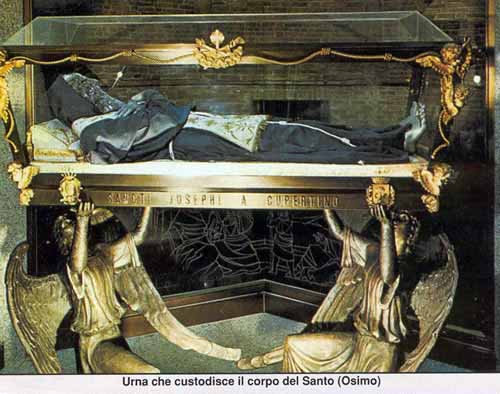
-tomb of St Joseph of Cupertino, Osimo, Italy. Notice, please, how the angels hold aloft his sarcophagus.
Love,
Matthew
Nov 16 – St Gertrude the Great, (1256?-1302)
On August 14, 1988, nearly three months after I had graduated from college, in a simple, private ceremony with no family present, I received my white, Dominican habit at St Gertrude’s priory where the novitiate of the Eastern Province of the Dominicans in the US is hosted.
Parishioners were always giving the novices small gifts. One artistic, mature, female parishioner who used to come all the time for vespers, gave each of us a small, oval wooden magnet on which she had created a lovely hand-painted picture of St Gertrude’s and our religious name. Mine says “Br. Matthew”. I still have it on our fridge here at home. It is a keepsake.
Gertrude, a Benedictine nun in Helfta (Saxony), was one of the great mystics of the 13th century. Together with her friend and teacher St. Mechtild, she practiced a spirituality called “nuptial mysticism,” that is, she came to see herself as the bride of Christ. Her spiritual life was a deeply personal union with Jesus and his Sacred Heart, leading her into the very life of the Trinity.
We don’t know who her parents were or what became of them, and she may been an orphan. Gertrude was raised in the Benedictine abbey of Saint Mary of Helfta, Eisleben, Saxony from age five. An extremely bright and dedicated student, she excelled in literature and philosophy, and when she was old enough, became a Benedictine nun.
At age 26, when she had become too enamored of philosophy, she received a vision of Christ who reproached her; from then on she studied the Bible and the works of the Church Fathers. Gertrude received other visions and mystical instruction, which formed the basis of her writings. She helped spread devotion to the Sacred Heart of Jesus. She had various mystical experiences, including a vision of Jesus, who invited her to rest her head on his breast to hear the beating of his heart. Her writings have been greatly praised by Saint Teresa and Saint Francis de Sales, and continue in print today.
But hers was no individualistic piety. Gertrude lived the rhythm of the liturgy, where she found Christ. In the liturgy and Scripture, she found the themes and images to enrich and express her piety. There was no clash between her personal prayer life and the liturgy.
“Lord, you have granted me your secret friendship by opening the sacred ark of your divinity, your deified heart, to me in so many ways as to be the source of all my happiness; sometimes imparting it freely, sometimes as a special mark of our mutual friendship. You have so often melted my soul with your loving caresses that, if I did not know the abyss of your overflowing condescensions ( voluntary assumption by the deity of equality with a creature regarded as inferior out of love), I should be amazed were I told that even your Blessed Mother had been chosen to receive such extraordinary marks of tenderness and affection” (Adapted from The Life and Revelations of Saint Gertrude).
“I praise, adore, bless and thank you to the best of my ability for your wise mercy and your merciful wisdom! For you, my Creator and my Redeemer, have sought to curb my stiff-necked obstinacy under your sweet yoke with the remedy best suited to my infirmity.”
-St. Gertrude the Great
“O Sacred Heart of Jesus, fountain of eternal life, Your Heart is a glowing furnace of Love. You are my refuge and my sanctuary.”
–St. Gertrude the Great
St Gertrude’s Prayer to the Sacred Heart of Jesus
“O Sacred Heart of Jesus, fountain of eternal life, Your Heart is a glowing furnace of Love. You are my refuge and my sanctuary. O my adorable and loving Savior, consume my heart with the burning fire with which Yours is aflamed. Pour down on my soul those graces which flow from Your love. Let my heart be united with Yours. Let my will be conformed to Yours in all things. May Your Will be the rule of all my desires and actions. Amen.”
St Gertrude showed “tender sympathy towards the souls in purgatory” and urged prayers for them. She is therefore invoked for souls in purgatory. Perhaps for that reason, to her name has been attached a prayer that, according to a legend of uncertain origin and date (neither are found in the Revelations of Saint Gertrude the Great), Our Lord promised to release a thousand souls from purgatory each time it was said. The prayer was extended to include living sinners as well.
“Eternal Father, I offer Thee the most Precious Blood of Thy Divine Son, Jesus Christ, in union with the Masses said throughout the world today, for all the Holy Souls in Purgatory, for sinners everywhere, for sinners in the Universal Church, for those in my own home and within my family. Amen.”
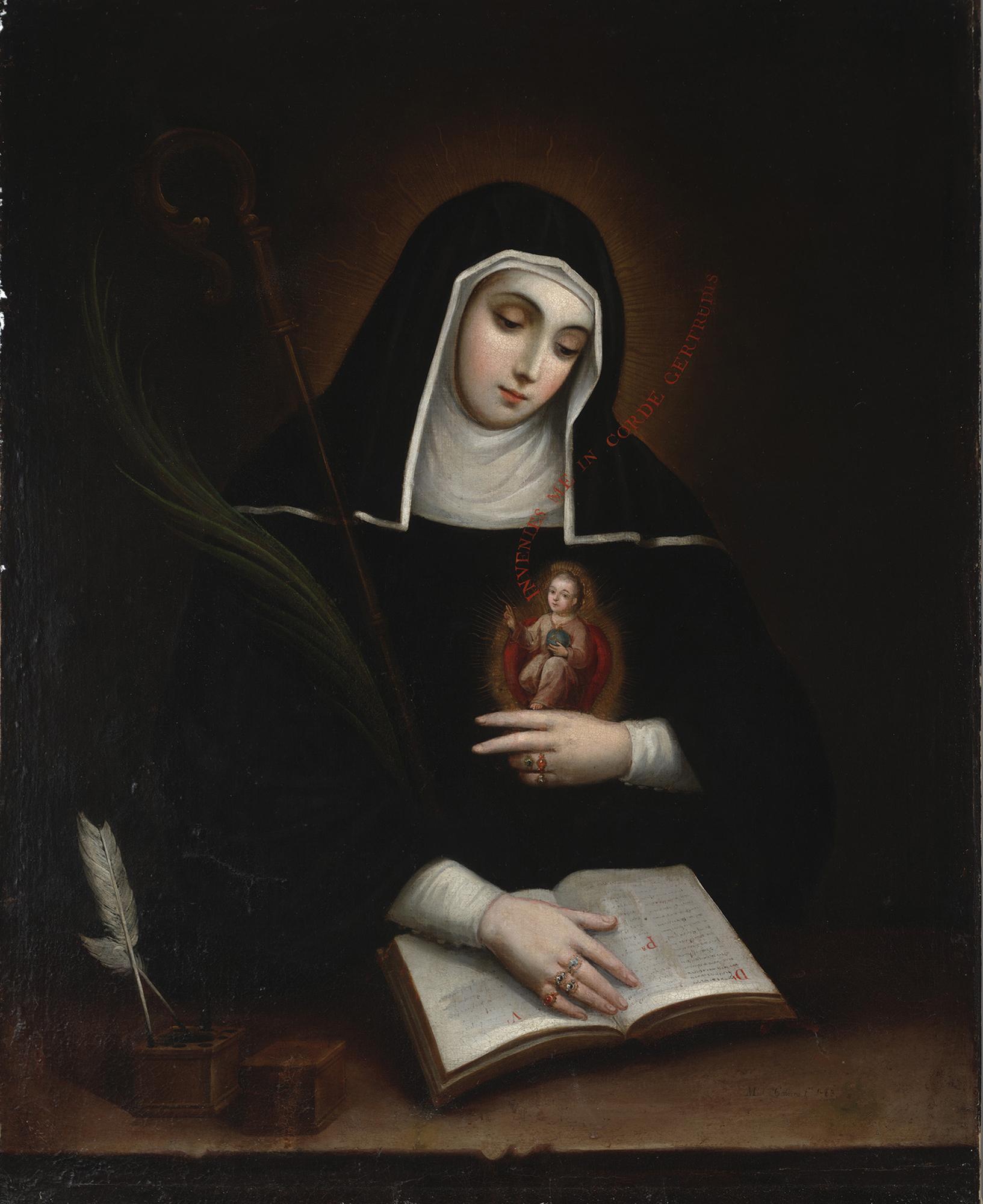
-St Gertrude, by Miguel Cabrera, 1763
In the above iconography of St Gertrude, you can see the Infant Jesus expressing the words “In corde Gertrudis inueunictis me” = “In the heart of Gertrude, you will find Me”.
Love,
Matthew
Nov 4 – St Charles Borromeo, (1538-1584), Cardinal Archbishop of Milan, Patron of Catechists, Great Catholic Reformer
Growing up in NJ, now so adversely challenged thanks to Sandy, a young person realizes there are really two societies within one entity. Northern NJ is more closely aligned with NYC; Southern NJ, Philadelphia. In Philadelphia, St Charles Borromeo Seminary looms large. As impressive inside as out, I know, having been a visitor on several occasions seeking the path of life.
Son of Gilberto II Borromeo, conte (count) of Arona, and Margherita de’ Medici (sister of Pope Pius IV), Carlo Borromeo was born on October the 2nd, 1538 at the castle of Arona on the shores of Lago Maggiore in northern Italy. The aristocratic Borromeo family’s coat of arms included the Borromean rings, sometimes taken to symbolize the Holy Trinity.
When Borromeo was about twelve years old, his uncle Giulio Cesare Borromeo, resigned to him an abbacy (the office and dignity of an abbot). Borromeo applied the revenue from this position in charity to the poor. He studied civil and canon law at Pavia. In 1554 his father died, and although he had an elder brother, Count Federigo, he was requested by the family to take the management of their domestic affairs. After a time, he resumed his studies, and in 1559 he took his doctoral degree. In 1560 his uncle, Cardinal Angelo de’ Medici, was raised to the pontificate as Pope Pius IV.
Pius IV named Borromeo as protonotary apostolic (secretary of state), entrusted with both the public and the privy seal of the ecclesiastical state. He then named Borromeo to the post of Cardinal of Romagna and the March of Ancona, and supervisor of the Franciscans, Carmelites and Knights of Malta. Like other wealthy young men, he went to the University of Pavia. Unlike many of them, however, he would have nothing to do with sinful activities. He seemed to be a slow student because he was not a good speaker, but he made good progress.
At age twenty-two, Borromeo was highly trusted at the papal court. Soon afterwards Pius IV raised him to the archbishop of Milan. In compliance with the pope’s desire, Borromeo lived in splendor to represent the glory of the church. He established an academy of learned persons, the Academy of the Vatican Nights, and published their memoirs as the Noctes Vaticanae.
He was always afraid that he might stray from God because of the many temptations around him. For this reason, he was careful to focus his attention on prayer and his duties and to make the effort to be humble and patient.
About the same time, Borromeo founded and endowed a college at Pavia, today known as Almo Collegio Borromeo, which he dedicated to Saint Justina of Padua. On the death of his elder brother Federigo, his family urged Borromeo to quit the church to marry and have children, so that the family name would not become extinct.
Borromeo declined the proposal. He worked even harder for the welfare of the church. Owing to his influence over Pius IV, he facilitated the final deliberations of the Council of Trent. He took a large share in the creation of the Tridentine Catechism (Catechismus Romanus).
After the death of his uncle, Pius IV (1566), Borromeo contributed materially to suppressing the cabals of the conclave. Subsequently he devoted himself wholly to the reformation of his diocese. It had deteriorated in practice owing to the 80-year absence of previous archbishops. Borromeo made numerous pastoral visits, and restored dignity to divine service.
In conformity with the decrees of the Council of Trent, which suggested simplifying church interiors, Borromeo cleared the cathedral of ornate tombs, rich ornaments, banners, and arms. He did not even spare the monuments of his own relatives. He divided the nave of the church into two compartments to separate the sexes at worship.
He extended his reforms to the collegiate churches, monasteries and even to the Confraternities of Penitents, particularly that of St. John the Baptist. This group was to attend to prisoners and those condemned to death, to give them help and support.
Borromeo believed that abuses in the church arose from ignorant clergy. Among his most important actions, he established seminaries, colleges and communities for the education of candidates for holy orders. His emphasis on Catholic learning greatly increased the preparation of men for priesthood and benefited their congregations.
In addition, Borromeo founded the fraternity of Oblates of St. Ambrose, a society of secular men who did not take orders, but devoted themselves to the church and followed a discipline of monastic prayers and study. They provided assistance to parishes where ordered by the church.
Though the Diet of Ilanz of 1524 and 1526 had proclaimed freedom of worship in the Republic of the Three Leagues, Saint Charles repressed Protestantism in the Swiss valleys. The Catholic Encyclopedia relates: “In November [1583] he began a visitation as Apostolic visitor of all the cantons of Switzerland and the Grisons, leaving the affairs of his diocese in the hands of Monsignor Owen Lewis, his vicar-general. He began in the Mesoleina Valley; here not only was there heresy to be fought, but also witchcraft and sorcery, and at Roveredo it was discovered that the provost, or rector, was the foremost in sorceries.” During his pastoral visit to the region, the Cardinal had about a hundred people arrested for practicing witchcraft. Ten women and the provost were condemned to “the flaming death”. They were put to death by being placed head-first in the fire.
Reacting to the pressure of the Protestant Reformation, Borromeo encouraged the Golden League formed in 1586 by Ludwig Pfyffer in Switzerland. Based in Lucerne, the organization (also called the Borromean League) linked activities of several Swiss Catholic cantons of Switzerland, which became the centre of Catholic Counter-Reformation efforts. This Inquisition-type organization was determined to expel heretics and burned some people at the stake. It created severe strains in the civil administration of the confederation, and it caused the break-up of Appenzell canton along religious lines.
In 1576, when Milan suffered an epidemic of the bubonic plague, Borromeo led efforts to accommodate the sick and bury the dead. He avoided no danger and spared no expense. He visited all the parishes where the contagion raged, distributing money, providing accommodation for the sick, and punishing those, especially the clergy, who were remiss in discharging their duties.
Borromeo met with much opposition to his reforms. The governor of the province, and many of the senators, addressed complaints to the courts of Rome and Madrid. They were apprehensive that the cardinal’s ordinances would encroach upon the civil jurisdiction.
Borromeo also faced staunch opposition of several religious orders, particularly that of the Humiliati (Brothers of Humility). Some members of that society formed a conspiracy against his life, and a shot was fired at him in the archiepiscopal chapel. His survival was considered miraculous.
He successfully attacked his Jesuit confessor, Giovanni Battista Ribera who, with other members of the college of Milan, was found to be guilty of unnatural offenses. This action increased Borromeo’s enemies within the church.
Borromeo’s manifold labors and austerities appear to have shortened his life. He was seized with an intermittent fever, and died at Milan, November 3rd, 1584. His last words were, “Behold, I come!” The city and the county of St Charles, Missouri, are named for him.
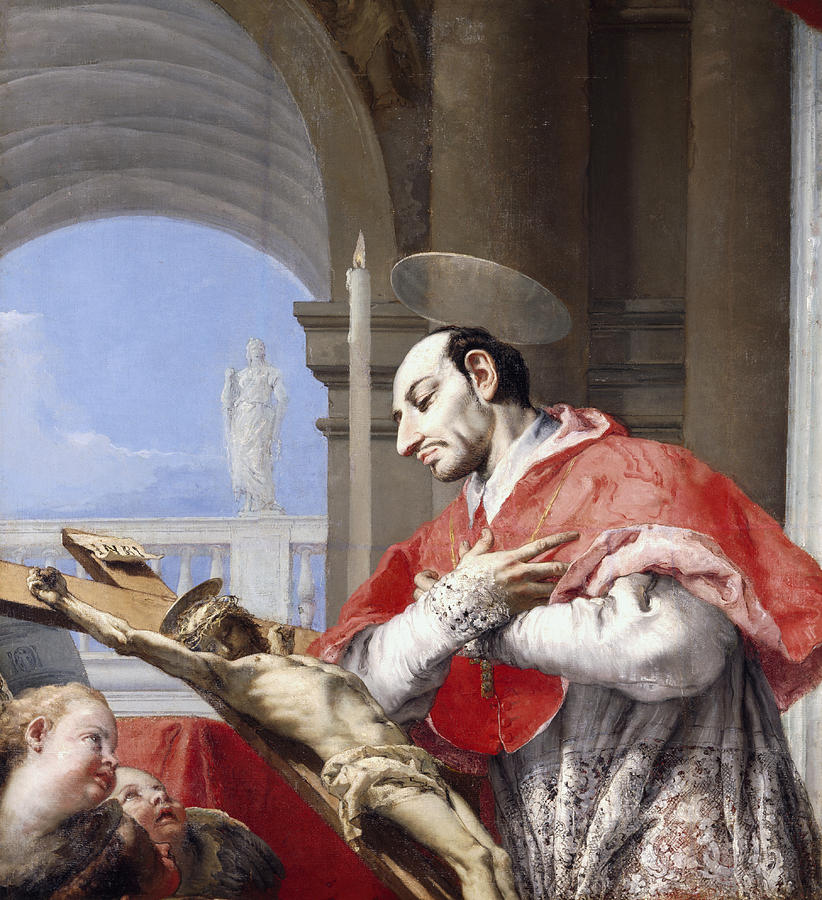
–St Charles Borromeo, ca 1767-1770, by Giovanni Battista Tiepolo (1696-1770), oil on canvas
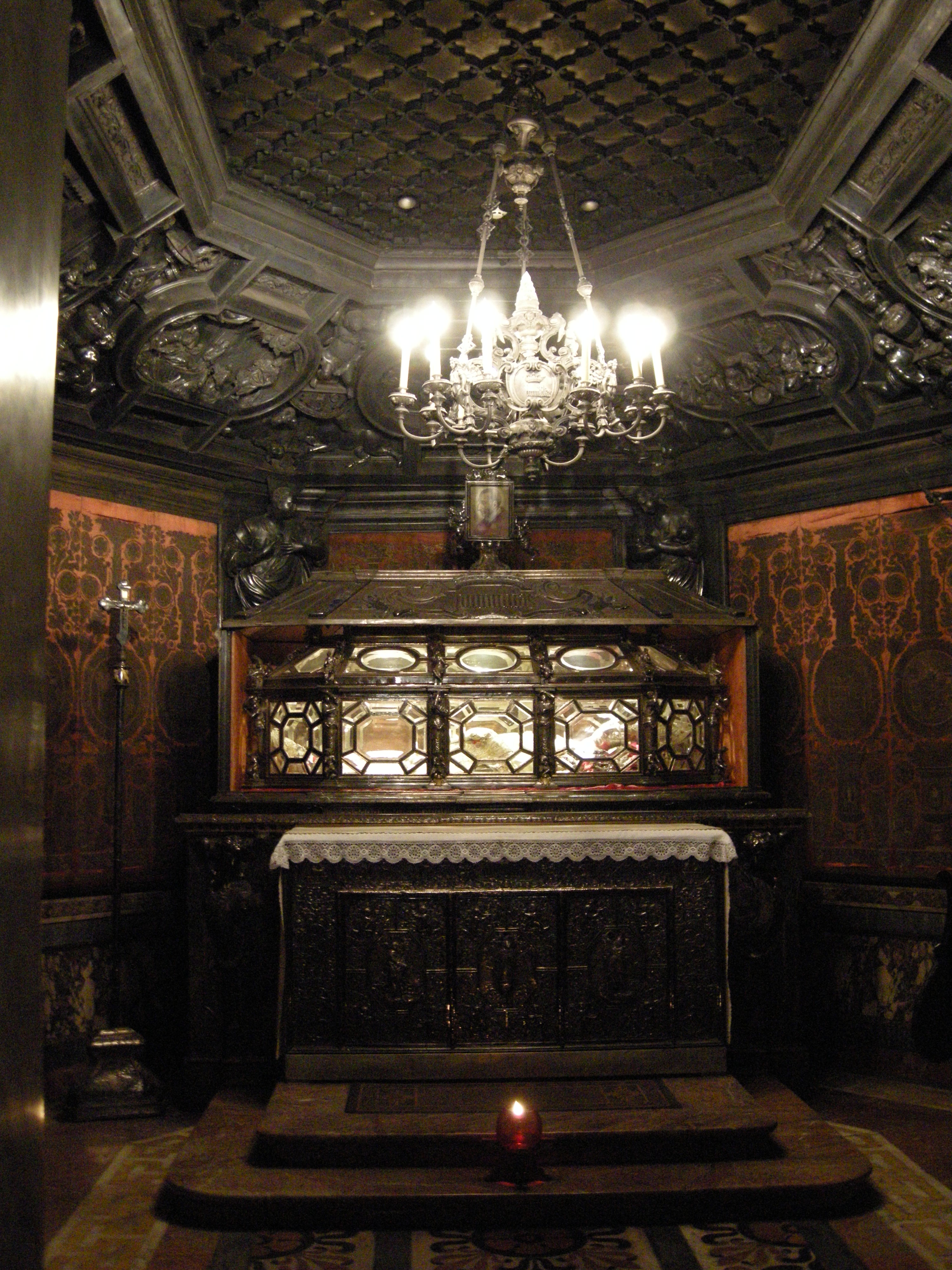
-the tomb crypt of St Charles Borromeo, Duomo di Milano
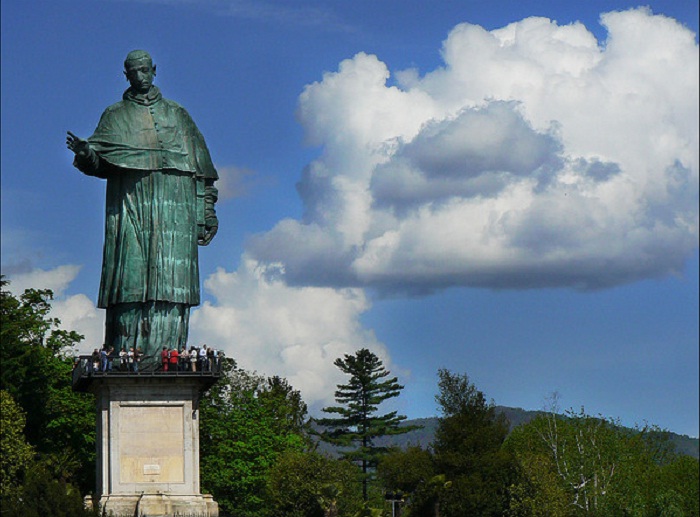
-The Colosso di San Borromeo, May 1698, (the giant statue of Saint Charles Borromeo), was for over two hundred years the largest statue in the world. Locals call him Carlone, (big Carlo, pronounced Car-low-nayh), and for over 200 years his statue, on a hilltop in Arona, Piemonte, was the tallest statue in the world, Including its base, it is over 114 feet high. One can climb a series of steep and scary stairs to reach the windows at the eyes and ears of St. Charles Borromeo statue, with a superb panoramic view awaiting!
This enormous statue made of copper and granite was built much earlier than the Statue of Liberty, designed by Giovanni Crespi Batiste called the Cerano and built by Siro Pianella and Bernardo Falcon. The work was completed in 1698 and on 19th May of that year Cardinal Federico Caccia, archbishop of Milan, solemnly blessed the monument dedicated to St. Charles Borromeo (who was born in Arona in 1538 and elected archbishop of Milan in 1565).
The statue is open to the public, who can climb up it via a spiral staircase, then a ladder going up into the head of San Carlo, which is possible to admire the beautiful sorroundings of Arona and Lake Maggiore. A few metres away is the Shrine of San Carlo, a great, austere, baroque style building dating from the seventeenth century, designed by the architect Francesco Richini.
A reconstruction of San Carlo’s original room, obtained by assembling furniture that had been saved from the Napoleonic destruction of the nearby Rocca Borromeo, is located inside (behind the altar). The saint’s relics are conserved in special, carved, wooden showcases beside the altar.
“I admit that we are all weak, but if we want help, the Lord God has given us the means to find it easily. Would you like me to teach you how to grow from virtue to virtue and how, if you are already recollected at prayer, you can be even more attentive next time, and so give God more pleasing worship? Listen, and I will tell you. If a tiny spark of God’s love already burns within you, do not expose it to the wind, for it may get blown out. Keep the stove tightly shut so that it will not lose its heat and grow cold. In other words, avoid distractions as well as you can. Stay quiet with God. Do not spend your time in useless chatter.
If teaching and preaching is your job, then study diligently and apply yourself to whatever is necessary for doing the job well. Be sure that you first preach by the way you live. If you do not, people will notice that you say one thing, but live otherwise, and your words will bring only cynical laughter and a derisive shake of the head.
We must meditate before, during and after everything we do. The prophet says: “I will pray, and then I will understand.”
This is the way we can easily overcome the countless difficulties we have to face day after day, which, after all, are part of our work. In meditation we find the strength to bring Christ to birth in ourselves and in other men.”
– Saint Charles Borromeo
“If we wish to make any progress in the service of God we must begin every day of our life with new eagerness. We must keep ourselves in the presence of God as much as possible and have no other view or end in all our actions but the divine honor.”
–St. Charles Borromeo
“Behold Jesus Christ crucified, Who is the only foundation of our hope; He is our Mediator and Advocate; the victim and sacrifice for our sins. He is goodness and patience itself; His mercy is moved by the tears of sinners, and He never refuses pardon and grace to those who ask it with a truly contrite and humbled heart.”
–St. Charles Borromeo
“Stay quiet with God […] we must meditate before, during, and after everything we do” (Acta Ecclesiae Mediolanensis 1599, 1177-1178, as cited in the Liturgy of the Hours). In everything we do, we ought to pray that it is in accord with God’s will. Saint Charles would emphasize this in an exhortation to his Milanese clergy: “Let us direct our counsels, thoughts, efforts and actions to the certain norm of the will of God” (-St Charles Borromeo, “Cultivating the Field Persistently,” delivered in 1569)
“Almighty God, You have generously made known to man the mysteries of Your life through Jesus Christ Your Son in the Holy Spirit. Enlighten my mind to know these mysteries which Your Church treasures and teaches. Move my heart to love them and my will to live in accord with them. Give me the ability to teach this Faith to others without pride, without ostentation, and without personal gain. Let me realize that I am simply Your instrument for bringing others to the knowledge of the wonderful things you have done for all your creatures. Help me to be faithful to this task that You have entrusted to me. Amen.”
-Saint Charles Borromeo
“Behold Jesus Christ crucified, Who is the only foundation of our hope; He is our Mediator and Advocate; the victim and sacrifice for our sins. He is goodness and patience itself; His mercy is moved by the tears of sinners, and He never refuses pardon and grace to those who ask it with a truly contrite and humbled heart.”
—St. Charles Borromeo
Prayer to St Charles Borromeo
O saintly reformer, animator of spiritual renewal of priests and religious, you organized true seminaries and wrote a standard catechism. Inspire all religious teachers and authors of catechetical books. Move them to love and transmit only that which can form true followers of the Teacher Who is Divine. Amen.
Love,
Matthew
Nov 5 – Servant of God Giorgio La Pira (1904-1977), The Godly Mayor – a job, a house, & music…
What can one person do? Certainly little in the modern world? Right? Certainly? This excuse is regularly used to avoid challenging questions one’s conscience may pose. The cost is one’s mental health and, possibly, one’s soul.
Giorgio La Pira was a charismatic and popular politician – the type of big city civic character who might seem familiar to Americans. What distinguishes La Pira is that this three-time mayor of Florence may well have been a saint. Governing in the 1950’s and 60’s he had an overriding concern for the poor, was a defender of the rights of workers and, later on, became an international apostle of peace.
On April 26, 2004, Italy celebrated the centenary of Giorgio La Pira. On that occasion, in a meeting with representatives from the National Association of Italian Municipalities, Pope John Paul II praised the former mayor of Florence as a man who “set forth with firmness his ideas as a believer and as a man who loved peace, inviting his interlocutors to a common effort to promote this basic good in various spheres: in society, politics, the economy, cultures and among religions.” Eighteen years earlier, in 1986, the formal process for the cause of the beatification of Giorgio La Pira began.
Even before his death, Giorgio La Pira was already considered a living saint by some in Italy. His clothes were alleged to have miraculous healing powers. Amintore Fanfani, La Pira’s friend and fellow Christian Democrat, was reported to have used an old hat of La Pira’s to cure minor illnesses suffered by his children. Who was this man?
Giorgio La Pira was born on January 09, 1904 in Pozzallo, a town in the province of Ragusa in Sicily. Born the eldest of six children, La Pira’s family was not wealthy. His father, Gaetano, worked in a packing house. However, like many Italian children, La Pira was brought up in a Catholic household that valued education. After moving to Messina to live with an uncle, La Pira received both a traditional education in the Classics as well as a business education, receiving a degree in accounting. Law school was the next step in an academic career that would eventually see the cheerful Sicilian awarded the Chair of Roman Law at the University of Florence in 1933.
While beloved by his students, La Pira eventually ran afoul of Italy’s Fascist regime. Having helped found the anti-fascist magazine Principles in 1939, La Pira became a target of Mussolini’s police, prompting La Pira to seek refuge in the Vatican City where he worked for L’Osservatore Romano, the newspaper of the Holy See. After the end of World War II, La Pira played an important role in shaping the future of the Italian Republic. As part of the Constituent Assembly, La Pira helped craft the new Italian constitution, standing firmly in favor of the legal indissolubility of the family and championing the authority of fathers within the family. In 1948, La Pira went to work for the government of Prime Minister Alcide De Gasperi as Undersecretary of Labor in the Ministry of Employment and Social Insurance.
During his period in the national government, La Pira became associated with the left-wing of the Christian Democratic Party, along with Giuseppe Dossetti, Amintore Fanfani, and Giuseppe Lazzati. Known as the “Little Professors” because of their impressive academic credentials and Christian idealism, the friends founded the journal Cronache Sociali, a left-leaning journal of Christian social thinking. La Pira’s writings on economics were heavily influenced by John Maynard Keynes and other British sources including Stafford Cripps and the Labour Party in general. For La Pira and many of his allies on the left-wing of the Christian Democratic Party, Clement Attlee’s Labour government in Great Britain was the model that post-war Italy ought to follow on questions of economics.
When La Pira became Mayor of Florence in 1951, he brought with him many of the economic ideas he developed while writing for the Cronache Sociali and working in the national government on problems of unemployment and other socio-economic issues. These ideas would be put to the test in a concrete fashion when La Pira was faced with a city suffering from high unemployment and a housing shortage. Wasting little time, La Pira’s administration burst into action, developing a number of public works projects designed to alleviate the city’s unemployment problem. Under La Pira’s watch, bridges destroyed during the war were rebuilt, water works and public transportation systems were repaired or built, low-cost public housing was constructed for the homeless residents of the city, and various artistic and cultural programs were developed. La Pira’s vision for Florence was a city of self-sufficient neighbourhoods with a vibrant cultural life.
Of course, La Pira’s administration is probably most famous for its extensive policy of municipalisation that earned him the love of workers and the hatred of many industrialists. In 1955, La Pira’s city government took over a failed foundry and turned over its operation to the workers, allowing them to elect their bosses from among their own ranks. In response to changes in national government policy that allowed evictions from rent-controlled apartments, La Pira requisitioned old Fascist buildings and even the villas of wealthy Florentines for the purpose of rehousing evicted tenants.
In perhaps his most famous action as Mayor of Florence, La Pira saved hundreds of jobs at the Pignone industrial plant, which at that time was making cotton-spinning machines for the textile industry. Due to a slump in demand in the textile business, Pignone was being closed down by its private owners. However, the workers refused to leave, sleeping and taking meals in the factory and continuing to work the machines. La Pira joined the workers in attending Mass and worked with the union leadership to find a resolution to the problem of the plant’s closure. Eventually, La Pira was able to convince Enrico Mattei, the head of ENI, Italy’s powerful state-run energy corporation, to take over the factory and place it under public ownership, thus saving more than one thousand jobs.
La Pira’s generosity with the public treasury was only matched by his own personal attitude toward those in need. It was not unusual to find the Mayor of Florence walking about with no shoes, no coat, and no umbrella, because he had given away his clothing to the poor. La Pira, who was a Dominican tertiary, lived in an unheated monastery cell in the Basilica of San Marco, although he sometimes lodged with a doctor friend when it was especially cold outside. His behavior caused him to be dubbed “the Saint” by the people of Florence. Indeed, despite the fact that he was hated by many businessmen in Italy, their allies in the Christian Democratic Party could not afford to replace La Pira with another candidate as he was seen as the only person who could defeat the Communists in left-wing Florence.
After La Pira served his final year as Mayor of Florence in 1964, he largely devoted himself to the cause of international peace, working to bring an end to conflicts in Vietnam and the Middle East in particular. His work in favor of disarmament and Third World development also merit mention, and the bespectacled Sicilian even travelled to Chile to try to prevent the coup d’état against President Salvador Allende.
In 1976, Giorgio La Pira returned to active politics at the request of the Christian Democratic Party. Despite ill-health, La Pira stood for election and won a seat in the Chamber of Deputies. La Pira’s last actions as a politician reflect the changing problems of the world he lived in. La Pira was a vehement opponent of abortion and fought against its legalization, with L’Osservatore Romano running his article “Confronting Abortion” on its front page on March 19, 1976. La Pira also spoke out against the increasing violence and materialism of modern society, connecting his opposition to abortion to his support for disarmament and world peace.
On November 05, 1977, Giorgio La Pira passed away. His funeral was unsurprisingly well attended, and the attendees included the thousands of workers whose jobs he saved at the Pignone factory and elsewhere.
Perhaps more than any other member of the Christian Democratic Left, La Pira actively embodied the ideals of a Christian version of social democracy. La Pira put into action his statement that every person was entitled to “a job, a house, and music,” even if it caused many people within his own Christian Democratic Party to accuse him of statism or “spurious Marxism,” as the venerable Don Luigi Sturzo, one of the founders of Italian Christian Democracy, put it.
La Pira responded to Don Sturzo by describing the dire unemployment situation in Florence, particularly among the young, and asking him what he would do if he were mayor. In our own age, when so many people are left out of work, when so many young people cannot start families because the market cannot provide enough work to form the economic basis of family life, Christians cannot shrink in fear from accusations of statism or Marxism. Giorgio La Pira provides us with a bold example of political action in favor of peace, family life, and social justice (including justice for the unborn) with real meaning, not just words.
In Cardinal Benelli’s sermon preached in the Duomo at La Pira’s funeral, he asserted that “everything about La Pira can be understood through faith, without faith nothing about him can be understood”. Nor is there any doubt that this is the sole key to understanding “the Professor’s” life.
His fundamental working hypothesis, expressed in every sort of circumstance and in every place, was always based on the certainty of the resurrection of Christ: “if Christ be risen, as He is risen…” he used to say, going on to affirm that the entire history of all peoples is conditioned by this event.
“The holiness of our century will have this characteristic. It will be a holiness of laypeople. We encounter on the streets those who within 50 years may be on the altars–along the streets, in factories, in parliament and in university classrooms.” -Giorgio La Pira
O God, You have given to Your servant Giorgio La Pira
the grace to testify admirably in the cultural, social and political life of our time.
Grant us the grace, we ask, that the Church may recognize his heroic virtues and is revered by the Christian people as inspirer of charity, justice, peace. Amen.
“There is no doubt that the Lord had placed in my soul the desire for priestly grace; only, however, that He wished that I remain in my lay garb to labor with more fecundity in the secular world far from Him. But the goal of my life is clearly marked out: to be the Lord’s missionary in the world; and this apostolate will be carried out!”
-April 1931 Giorgio La Pira (from the letter to his aunt, Settimia Occhipinti)
“One last thing: I am not a priest, as you have supposed: Jesus did not want that of me! I am just a young man to whom Jesus has given a great grace: the desire to love Him without limits and to have Him be loved without limits.”
-Easter 1933 (16 April) Giorgio La Pira (from the letter to the Mother Prioress of Santa Maria Maddalena de’ Pazzi)
“Then the LORD asked Cain, “Where is your brother Abel?” He answered, “I do not know. Am I my brother’s keeper?”
-Gen 4:9
Love,
Matthew
Oct 16 – St Richard Gwyn, (1537-1584) – Layman, Husband, Father, Martyr
Richard Gwyn (anglicized “White”) was born at Llanilloes, Montgomeryshire, Wales. He studied at Oxford and then at St John’s College, Cambridge, but his studies were interrupted in 1558 when Elizabeth I ascended the throne and Catholics were expelled from the universities.
He returned to Wales and became a teacher, first at Overton in Flintshire, then at Wrexham and other places, acquiring a considerable reputation as a Welsh scholar. He married and had six children, three of whom survived him. He was pressured to become an Anglican and succumbed briefly, but returned to the Catholic faith after a sudden illness and remained steadfast in it thereafter, about the same time as Catholic priests came back to Wales.
His adherence to the old faith was noted by the Bishop of Chester, who brought pressure on him to conform to the Anglican faith. It is recorded in an early account of his life that:
“…[a]fter some troubles, he yielded to their desires, although greatly against his stomach … and lo, by the Providence of God, he was no sooner come out of the church but a fearful company of crows and kites so persecuted him to his home that they put him in great fear of his life, the conceit whereof made him also sick in body as he was already in soul distressed; in which sickness he resolved himself (if God would spare his life) to return to a Catholic.”
He frequently had to change his home and place of work to avoid fines and imprisonment, but he was finally arrested in 1579 and imprisoned in Ruthin gaol (jail). He was offered his freedom if he would conform. After escaping and spending a year and a half on the run, he spent the rest of his life in prison. He was fined astronomical sums for not attending the Anglican church services (recusancy), and was carried to church in irons more than once; but he would disrupt the service by rattling his irons and heckling, which led to further astronomical fines, but was not otherwise useful. Furious at him, his jailers put him in the stocks for many hours where many people came to abuse and insult and spit on him.
Taunted by a local Anglican priest who claimed that the keys of the Church were given no less to him than to St. Peter. “There is this difference”, Gwyn replied, “namely, that whereas Peter received the keys to the Kingdom of Heaven, the keys you received were obviously those of the beer cellar.” The queen’s men wanted him to give them the names of other Catholics, but Richard would not do so.
Gwyn was fined £280 for refusing to attend Anglican church services, and another £140 for “brawling”, while in chains, when they took him there. When asked what payment he could make toward these huge sums, he answered, “Six-pence”. Gwyn and two other Catholic prisoners, John Hughes and Robert Morris, were ordered into court in the spring of 1582 where, instead of being tried for an offence, they were given a sermon by an Anglican minister. However, they started to heckle him (one in Welsh, one in Latin and one in English) to the extent that the exercise had to be abandoned.
In 1580 he was transferred to Wrexham, where he suffered much persecution, being forcibly carried to the Church of England service, and being frequently taken to court at different assizes to be continually questioned, but was never freed from prison; he was removed to the Council of the Marches, and later in the year suffered torture at Bewdley and Bridgenorth before being sent back to Wrexham. There he remained a prisoner till the Autumn Assizes, when he was brought to trial on 9 October, found guilty of treason and sentenced to be executed. At his trial, men were paid to lie about him, as one of them later admitted. The men on the jury were so dishonest that they asked the judge whom he wanted them to condemn.
Richard Gwyn, John Hughes and Robert Morris were indicted for high treason in 1584 and were brought to trial before a panel headed by the Chief Justice of Chester, Sir George Bromley. Witnesses gave evidence that they retained their allegiance to the Catholic Church, including that Gwyn composed “certain rhymes of his own making against married priests and ministers” and “[T]hat he had heard him complain of this world; and secondly, that it would not last long, thirdly, that he hoped to see a better world [this was construed as plotting a revolution]; and, fourthly, that he confessed the Pope’s supremacy.” The three were also accused of trying to make converts.
Again his life was offered him on condition that he acknowledge the queen as supreme head of the Church. His wife, Catherine, and one of their children were brought to the courtroom and warned not to follow his example. She retorted that she would gladly die alongside her husband; she was sure, she said, that the judges could find enough evidence to convict her if they spent a little more money. She consoled and encouraged her husband to the last. He suffered on 16 October 1584, where he was hung, drawn, and quartered. On the scaffold he stated that he recognised Elizabeth as his lawful queen but could not accept her as head of the Church in England.
Just before Gwyn was hanged he turned to the crowd and said, “I have been a jesting fellow, and if I have offended any that way, or by my songs, I beseech them for God’s sake to forgive me.” The hangman pulled on his leg irons hoping to put him out of his pain. When he appeared dead they cut him down, but he revived and remained conscious through the disembowelling, until his head was severed. He cried out in pain, “Holy God, what is this?” To which he was replied, “An execution of her majesty the queen.” His last words, in Welsh, were reportedly “Iesu, trugarha wrthyf” (“Jesus, have mercy on me”). The beautiful religious poems, four carols and a funeral ode, Richard wrote in prison are still in existence. In them, he begged his countrymen of Wales to be loyal to the Catholic faith.
We can greatly admire St. Richard for his bravery. His willingness to suffer for what he believed in is inspiring. Let’s ask St. Richard to make us as strong in our convictions as he was. Relics of St Richard Gwyn are to be found in the Cathedral Church of Our Lady of Sorrows, seat of the Bishop of Wrexham and also in the Catholic Church of Our Lady and Saint Richard Gwyn, Llanidloes.
The incident of the birds mentioned in Richard’s “Early life” here is one of several strange events in Richard Gwyn’s life. Once when he was brought before a court, the clerk who read the indictment suddenly lost his vision and had to be replaced before the proceedings could resume. The judge cautioned those present not to report the incident, so that Catholics could not claim that it was a miracle. On another occasion, the judge, who later sentenced Richard to death, became inexplicably speechless in court.
St Richard Gwyn, faithful husband, father, and Catholic, pray for us!
Love,
Matthew
Oct 15 – St Teresa of Avila, OCD, (1515-1582) – Religious, Mystic, Doctor of the Church
Kelly & I, ESPECIALLY Kelly, are learning A LOT about children, having a daughter of our own. It used to be people would utter the number of children they have, and it would be a number. And I would think or say, “Isn’t that nice!”, or pay some other innocuous compliment. From the experience of one, now, my eyes ever widen wider and my jaw drops ever further given the same number! And, I stop breathing. What a gift! What a commitment!
With Mara, for me, one was easy, two was a breeze, THREE IS STILL GOING ON!!!! Whatever I say about my experience as a father multiply by a million, or more, for Kelly! It is and always will be MUCH harder for her, as a mother! Praise her! Praise YOU, Kelly!
My own respect for my own parents has reached unimaginably profound levels I never could have conceived of or fantasized about before. Six! w/twins! Life has many realities you have to actually experience to begin to appreciate. Parenthood and marriage are some of those.
One child, alone, certainly MAKES an impression! We can always immediately tell the waiters or waitresses who DO NOT have children! They place the food immediately in front of Mara! Yikes! We HAVE TO create an area, a “buffer zone” around her, clearing away any possible projectile from within her reach! Having children is a joyful, Divine gift and vocation! Praise Him! I love being a father and hope to be again, if I play my cards right! 🙂

“Misericordias Domini in aeternum cantabo – The mercies of the Lord I will sing forever.” – motto of St Teresa of Avila (Ps 88:2)
At seven, Teresa and her brother Rodrigo loved to read the lives of the saints and martyrs. It seemed to them that the martyrs got to heaven an easy way. The two children set out secretly to go to a faraway land, where they hoped they would die for Christ, being beheaded by the Moors. But, fortunately, they had not gotten far when they met an uncle! He took them back to their worried mother at once. Next the children decided to be hermits in their garden. This didn’t work out either. They could not get enough stones together to build their huts! Foiled, again!
Born 28 March 1515 at Avila, Castile, Spain as Teresa Sanchez Cepeda Davila y Ahumada, Teresa herself wrote down these amusing stories of her childhood. She was born to Spanish nobility, the daughter of Don Alonso Sanchez de Cepeda and Doña Beatriz.
In 1528, when Teresa was 15, her mother died, leaving behind 10 children. Teresa was the “most beloved of them all.” She was of medium height, large rather than small, and generally well proportioned. In her youth she had the reputation of being quite beautiful, and she retained her fine appearance until her last years. Her personality was extroverted, her manner affectionately buoyant, and she had the ability to adapt herself easily to all kinds of persons and circumstances. She was skillful in the use of the pen, in needlework, and in household duties. Her courage and enthusiasm were readily kindled, as exemplified by her and Rodrigo’s adventures. Seeing his daughter’s need of prudent guidance, her father entrusted her to the Augustinian nuns at Santa Maria de Gracia in 1531.
The fact is that when she became a teenager she changed. Teresa read so many novels and foolish romances that she lost much of her love for prayer. She began to think more of dressing up to look pretty. She gave some thought to marriage. But after she recovered from a bad illness, Teresa read a book about the great St. Jerome. Then and there, she made up her mind to become a bride of Christ. She entered the Carmelite Order in 1536. Her father opposed this, but Teresa prevailed.
As a nun, Teresa often found it very hard to pray. Besides that, she had poor health. Teresa wasted time every day in long, foolish conversations. But one day, in front of a picture of Jesus, “the sorely wounded Christ”, she felt great sorrow that she did not love God more. She started then to live for Jesus alone, no matter what sacrifice had to be made. In return for her love, the Lord gave St. Teresa the privilege of hearing Him speak to her. She learned to pray in a marvelous way, too. These mystical experiences caused much controversy. Teresa’s conduct was more relaxed than the common ascetical practices of the time. Many of her acquaintances and friends accused her visions of being occasioned by the devil.
One confessor was so sure that the visions were from the devil that he told her to make an obscene gesture called the “fig” every time she had a vision of Jesus. She cringed but did as she was ordered, all the time apologizing to Jesus. Fortunately, Jesus didn’t seem upset but told her that she was right to obey her confessor. In her autobiography she would say, “I am more afraid of those who are terrified of the devil than I am of the devil himself.”
I love Church technical terms: exegesis, hermeneutical arch, etc. One of Teresa’s most famous mystical experiences was the transverberation of her heart, immortalized by Bernini in marble in the Church of Santa Maria della Vittoria in Rome.
“I saw in his hand a long spear of gold, and at the iron’s point there seemed to be a little fire. He appeared to me to be thrusting it at times into my heart, and to pierce my very entrails; when he drew it out, he seemed to draw them out also, and to leave me all on fire with a great love of God. The pain was so great, that it made me moan; and yet so surpassing was the sweetness of this excessive pain, that I could not wish to be rid of it. The soul is satisfied now with nothing less than God. The pain is not bodily, but spiritual; though the body has its share in it. It is a caressing of love so sweet which now takes place between the soul and God, that I pray God of His goodness to make him experience it who may think that I am lying.” –Chapter XXIX; Part 17, Teresa’s Autobiography
Teresa felt that the best evidence that her delights came from God was that the experiences gave her peace, inspiration, and encouragement. “If these effects are not present I would greatly doubt that the raptures come from God; on the contrary I would fear lest they be caused by rabies.”
Sometimes, however, she couldn’t avoid complaining to her closest Friend about the hostility and gossip that surrounded her. When Jesus told her, “Teresa, that’s how I treat my friends” Teresa responded, “No wonder You have so few friends.”
St. Teresa of Avila is well known as a great reformer of the Carmelite order and for having opened sixteen new Carmelite convents. When plans leaked out about her first convent, St. Joseph’s, she was denounced from the pulpit, told by her sisters she should raise money for the convent she was already in, and threatened with the Inquisition. The town started legal proceedings against her.
She was called “a restless, disobedient gadabout who has gone about teaching as though she were a professor” by the papal nuncio. When her former convent voted her in as prioress, the leader of the Carmelite order excommunicated the nuns. A vicar general stationed an officer of the law outside the door to keep her out. The other religious orders opposed her wherever she went. She often had to enter a town secretly in the middle of the night to avoid causing a riot.
And the help she received was sometimes worse than the hostility. A princess ordered Teresa to found a convent and then showed up at the door with luggage and maids. When Teresa refused to order her nuns to wait on the princess on their knees, the princess denounced Teresa to the Inquisition.
To Teresa, spiritual life was an attitude of love, not a rule. Although she proclaimed poverty, she believed in work, not in begging. She believed in obedience to God more than penance. If you do something wrong, don’t punish yourself — change. When someone felt depressed, her advice was that she go some place where she could see the sky and take a walk. When someone was shocked that Teresa was going to eat well, she answered, “There’s a time for partridge and a time for penance.” To her brother’s wish to meditate on hell, she answered, “Don’t.”
In another town, they arrived at their new house in the middle of the night, only to wake up the next morning to find that one wall of the building was missing.
Why was everyone so upset? Teresa said, “Truly it seems that now there are no more of those considered mad for being true lovers of Christ.” No one in religious orders or in the world wanted Teresa reminding them of the way God said they should live.
Teresa looked on these difficulties as good publicity. Soon she had postulants clamoring to get into her reform convents. Many people thought about what she said and wanted to learn about prayer from her. Soon her ideas about prayer swept not only through Spain but all of Europe. She also left a significant legacy of writings, which represent important benchmarks in the history of Christian mysticism. These works include the “Way of Perfection” and the “Interior Castle”.
____________________________
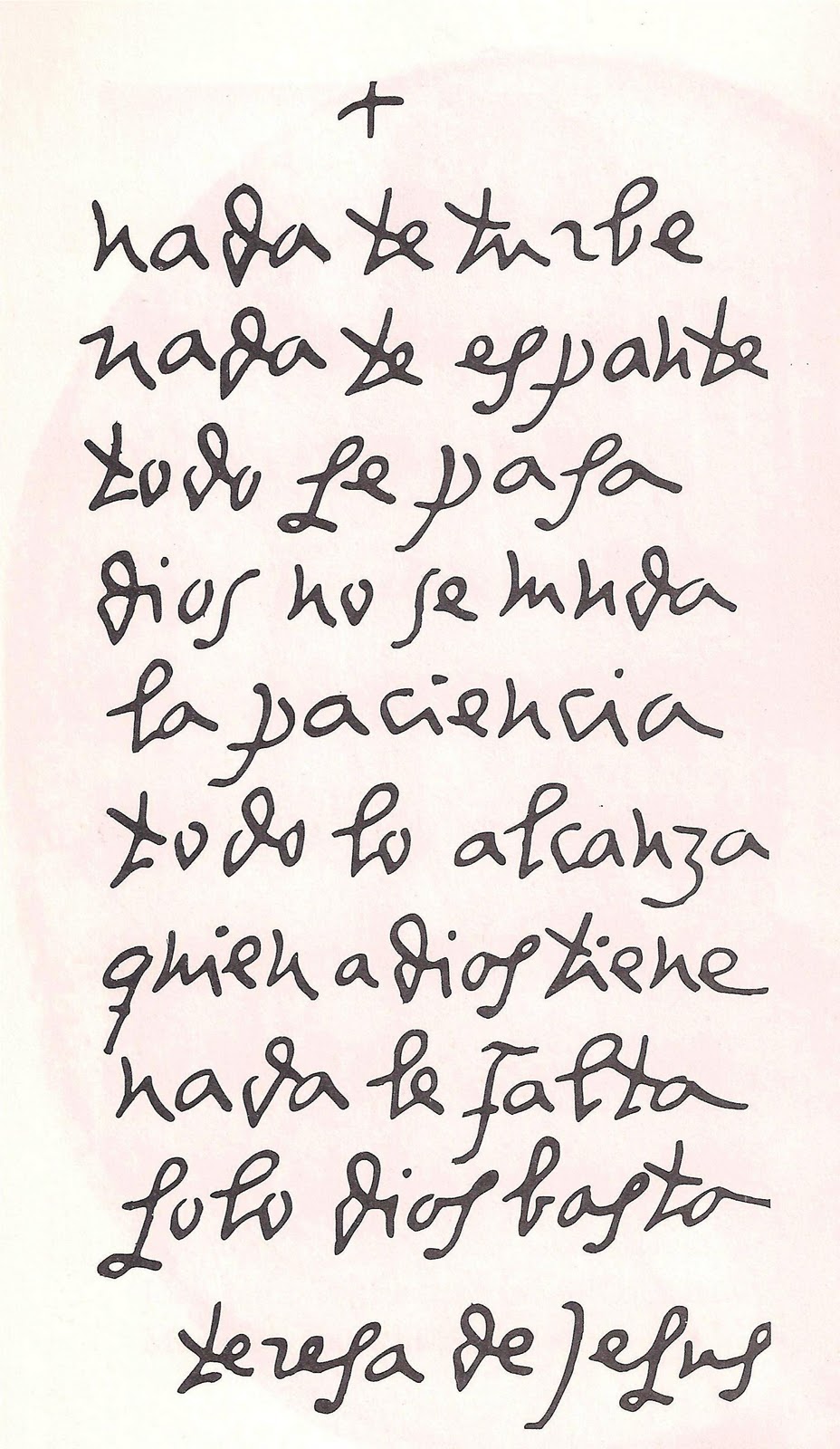
“Let nothing trouble you, let nothing make you afraid. All things pass away. God never changes. Patience obtains everything. God alone is enough.” – Saint Teresa of Avila
“God, deliver me from sullen saints”. – Saint Teresa of Avila
“It is love alone that gives worth to all things.” -St. Teresa of Avila
“To be humble is to walk in truth.” -St. Teresa of Avila
“Oh my Lord! How true it is that whoever works for You is paid in
troubles! And what a precious price to those who love You if we understand its value.” – Saint Teresa of Avila
“There is more value in a little study of humility and in a single act of it than in all the knowledge in the world.” – Saint Teresa of Avila
“To have courage for whatever comes in life—everything lies in that.”
-St. Teresa of Avila
“The closer one approaches to God, the simpler one becomes.”
—St. Teresa of Avila
“Learn to suffer for Jesus Christ without letting others perceive it.”
-St. Teresa of Avila
“Although I abandoned you, Lord, you did not abandon me so completely as not to turn to raise me up by always holding out your hand to me. And often times, Lord, I did not want it; nor did I desire to understand how often you called me again.” —St. Teresa of Avila
“We need no wings to go in search of Him, but have only to look upon Him present within us.” – Saint Teresa of Avila
“For prayer is nothing else than being on terms of friendship with God.”
–St. Teresa of Avila
“There are more tears shed over answered prayers than over unanswered prayers.”
—St. Teresa of Avila
“Lord, grant that I may always allow myself to be guided by You,
always follow Your plans,
and perfectly accomplish Your Holy Will.
Grant that in all things, great and small,
today and all the days of my life,
I may do whatever You require of me.
Help me respond to the slightest prompting of Your Grace,
so that I may be Your trustworthy instrument for Your honour.
May Your Will be done in time and in eternity by me,
in me, and through me. Amen.”
-Saint Teresa of Ávila
“Once, while I was wondering why Our Lord so dearly loves the virtue of humility, the thought suddenly struck me, without previous reflection, that it is because God is the supreme Truth and humility is the truth, for it is the most true that we have nothing good of ourselves but only misery and nothingness: whoever ignores this, lives a life of falsehood. They that realize this fact most deeply are the most pleasing to God, the supreme Truth, for they walk in the truth.”
—St. Teresa of Avila, Interior Castle
“If we but paused for a moment to consider attentively what takes place in this Sacrament of the Eucharist, I am sure that the thought of Christ’s love for us would transform the coldness of our hearts into a fire of love and gratitude.”
–St. Teresa of Avila – Teresa of Jesus
“Dream that the more you struggle, the more you prove the love that you bear your God, and the more you will rejoice one day with your Beloved, in a happiness and rapture that can never end.” -Saint Teresa of Avila
“Hope, O my soul, hope. You know neither the day nor the hour. Watch carefully, for everything passes quickly, even though your impatience makes doubtful what is certain, and turns a very short time into a long one.” – Saint Teresa of Avila
“Truth suffers, but never dies.” -St. Teresa of Avila
“Perhaps we do not know what love is, nor does this greatly surprise me. Love does not consist in great sweetness of devotion, but in a fervent determination to strive to please God in all things, in avoiding, as far as possible, all that would offend Him, and in praying for the increase of the glory and honor of His Son and for the growth of the Catholic Church.”
—St. Teresa of Avila, Interior Castle
“Let us not fancy that if we cry a great deal we have done all that is needed—rather we must work hard and practice the virtues: that is the essential—leaving tears to fall when God sends them, without trying to force ourselves to shed them. Then, if we do not take too much notice of them, they will leave the parched soil of our souls well watered, making it fertile in good fruit; for this is the water which falls from Heaven. … I think it is best for us to place ourselves in the presence of God, contemplate His mercy and grandeur and our own vileness and leave Him to give us what He will, whether water or drought, for He knows best what is good for us; thus we enjoy peace and the devil will have less chance to deceive us.”
—St. Teresa of Avila, Interior Castle
“Prayer is an act of love; words are not needed. Even if sickness distracts from thoughts, all that is needed is the will to love.” -St. Teresa of Avila
“Beginners must realize that in order to give delight to the Lord they are starting to cultivate a garden on very barren soil, full of abominable weeds. His Majesty pulls up the weeds and plants good seed. Now let us keep in mind that all of this is already done by the time a soul is determined to practice prayer and has begun to make use of it. And with the help of God we must strive like good gardeners to get these plants to grow and take pains to water them so that they don’t wither but come to bud and flower and give forth a most pleasant fragrance to provide refreshment for this Lord of ours.” —St. Teresa of Avila
“The important thing is not to think much but to love much; do, then, whatever most stirs you to love.” -St. Teresa of Avila
“Christ has no body on earth but yours, no hands but yours, no feet but yours.” -St. Teresa of Avila
“Do not suppose that one who suffers does not pray; he prays, since he offers his sufferings to God, and often far better than one who is racking his brains in solitude and who fancies, if he manages to wring out a few tears, that this is true prayer.”
—St. Teresa of Avila
“If Christ Jesus dwells in a man as his friend and noble leader, that man can endure all things, for Christ helps and strengthens us and never abandons us. He is a true friend. And I clearly see that as we expect to please Him and receive an abundance of His graces, God desires that these graces must come to us from the hands of Christ, through His most sacred humanity, in which God takes delight. All blessings come to us through our Lord. He will teach us, for in beholding His life we find that He is the best example.
What more do we desire from such a good Friend at our side? Unlike our friends in the world, He will never abandon us when we are troubled or distressed. Blessed is the one who truly loves Him and always keeps Him near. Whenever we think of Christ we should recall the love that led Him to bestow on us so many graces and favors, and also the great love God showed in giving us in Christ a pledge of His love; for Love calls for love in return.
Let us strive to keep this always before our eyes and to rouse ourselves to love Him. For soon the Lord will grant us the grace of impressing His love on our hearts, and all will become easy for us and we shall accomplish great things quickly and without effort.” – Saint Teresa of Avila
“While in a state like this the soul will find profit in nothing, and hence, being as it is in mortal sin, none of the good works it may do will be of any avail to win it glory; for they will not have their origin in that First Principle, which is God, through Whom alone our virtue is true virtue. -St Teresa of Avila, “Interior Castle”, about when the soul is in mortal sin.
“Do not suppose that after advancing the soul to such a state God abandons it so easily that it is light work for the devil to regain it. When His Majesty sees it leaving Him, He feels the loss so keenly that He gives it in many a way a thousand secret warnings which reveal to it the hidden danger. In conclusion, let us strive to make constant progress: we ought to feel great alarm if we do not find ourselves advancing, for without doubt the evil one must be planning to injure us in some way; it is impossible for a soul that has come to this state not to go still farther, for love is never idle. Therefore it is a very bad sign when one comes to a standstill in virtue.”
—St. Teresa of Avila, Interior Castle
“Do you know what it is to be truly spiritual? It is for men to make themselves the slaves of God—branded with His mark, which is the Cross. … Unless you make up your minds to this, never expect to make much progress, for as I said humility is the foundation of the whole building and unless you are truly humble, Our Lord, for your own sake, will never permit you to rear it very high lest it should fall to the ground. Therefore, sisters, take care to lay a firm foundation by seeking to be the least of all and the slave of others, watching how you can please and help them, for it will benefit you more than them. Built on such strong rocks, your castle can never go to ruin. I insist again: your foundation must not consist of prayer and contemplation alone: unless you acquire the virtues and praise them, you will always be dwarfs; and please God no worse may befall you than making no progress, for you know that to stop is to go back—if you love, you will never be content to come to a standstill.”
—St. Teresa of Avila, Interior Castle
“We must beg God constantly in our prayers to uphold us by His hand; we should keep ever in our minds the truth that if He leaves us, most certainly we shall fall at once into the abyss, for we must never be so foolish as to trust in ourselves. After this I think the greatest safeguard is to be very careful and to watch how we advance in virtue; we must notice whether we are making progress or falling back in it, especially as regards the love of our neighbor, the desire to be thought the least of all and how we perform our ordinary, everyday duties. If we attend to this and beg Our Lord to enlighten us, we shall at once perceive our gain or loss.”
—St. Teresa of Avila, Interior Castle
“Yet such are the pity and compassion of this Lord of ours, so desirous is He that we should seek Him and enjoy His company, that in one way or another He never ceases calling us to Him . . . God here speaks to souls through words uttered by pious people, by sermons or good books, and in many other such ways. Sometimes He calls souls by means of sickness or troubles, or by some truth He teaches them during prayer, for tepid as they may be in seeking Him, yet God holds them very dear.”
—St. Teresa of Avila, Interior Castle
“I believe we shall never learn to know ourselves except by endeavoring to know God, for, beholding His greatness we are struck by our own baseness, His purity shows our foulness, and by meditating on His humility we find how very far we are from being humble. Two advantages are gained by this practice. First, it is clear that white looks far whiter when placed near something black, and on the contrary, black never looks so dark as when seen beside something white. Secondly, our understanding and will become more noble and capable of good in every way when we turn from ourselves to God: it is very injurious never to raise our minds above the mire of our own faults.”
—St. Teresa of Avila, Interior Castle
“The queen is the piece that can carry on the best battle in this game, and all the other pieces help. There’s no queen like humility for making the King surrender. Humility drew the King from heaven to the womb of the Virgin, and with it, by one hair, we will draw Him to our souls. And realize that the one who has more humility will be the one who possesses Him more; and the one who has less will possess Him less.
—St. Teresa of Avila from the book The Way of Prayer
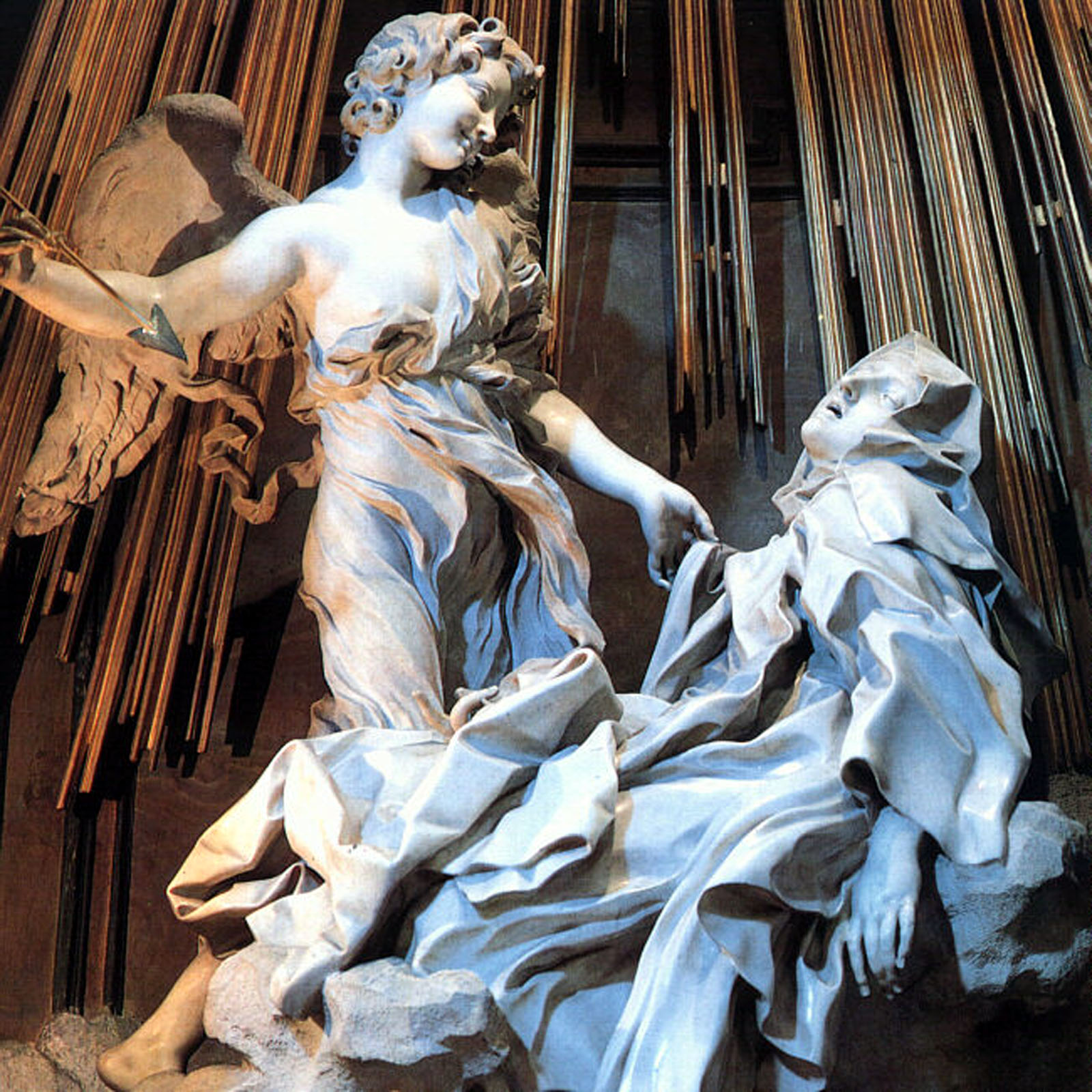
-Ecstasy of St Teresa, (1647-1652), Giovanni Lorenzo Bernini, Santa Maria della Vittoria, Rome
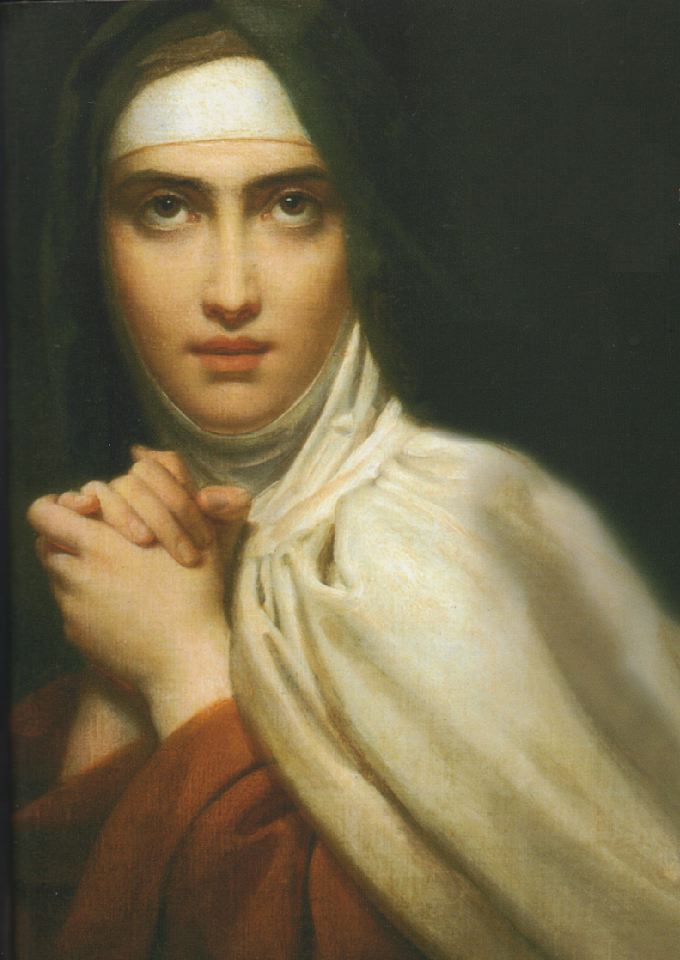
–Teresa of Ávila, 1827, by François Gérard (1770−1837)
Prayer to Saint Teresa of Avila
Dear wonderful saint, model of fidelity to your vows, you gladly carried a heavy cross following in the steps of Christ, Who chose to be crucified for us. You realized that God, like a merciful Father, chastises those whom He loves – which to those who love this world seems silly indeed. Grant to those who suffer like you relief from their affliction, if this be the will and the plan of God. Amen.
Love,
Matthew

